The Aegis System Development Using Agile DSDM
VerifiedAdded on 2023/05/27
|30
|6268
|69
AI Summary
This article discusses the development of the Aegis System using DSDM Agile methodology for disaster management. It explains the reasons for choosing DSDM, its strengths and limitations, stakeholder roles, and more. The article also covers MoSCoW technique, user stories, prototypes, iterative development, and first cut class diagram. The subject is disaster management, and the course code and college/university are not mentioned.
Contribute Materials
Your contribution can guide someone’s learning journey. Share your
documents today.

Running head: THE AEGIS SYSTEM DEVELOPMENT USING AGILE DSDM
The Aegis System Development Using Agile DSDM
Name of the Student
Name of the University
Author’s note:
The Aegis System Development Using Agile DSDM
Name of the Student
Name of the University
Author’s note:
Secure Best Marks with AI Grader
Need help grading? Try our AI Grader for instant feedback on your assignments.
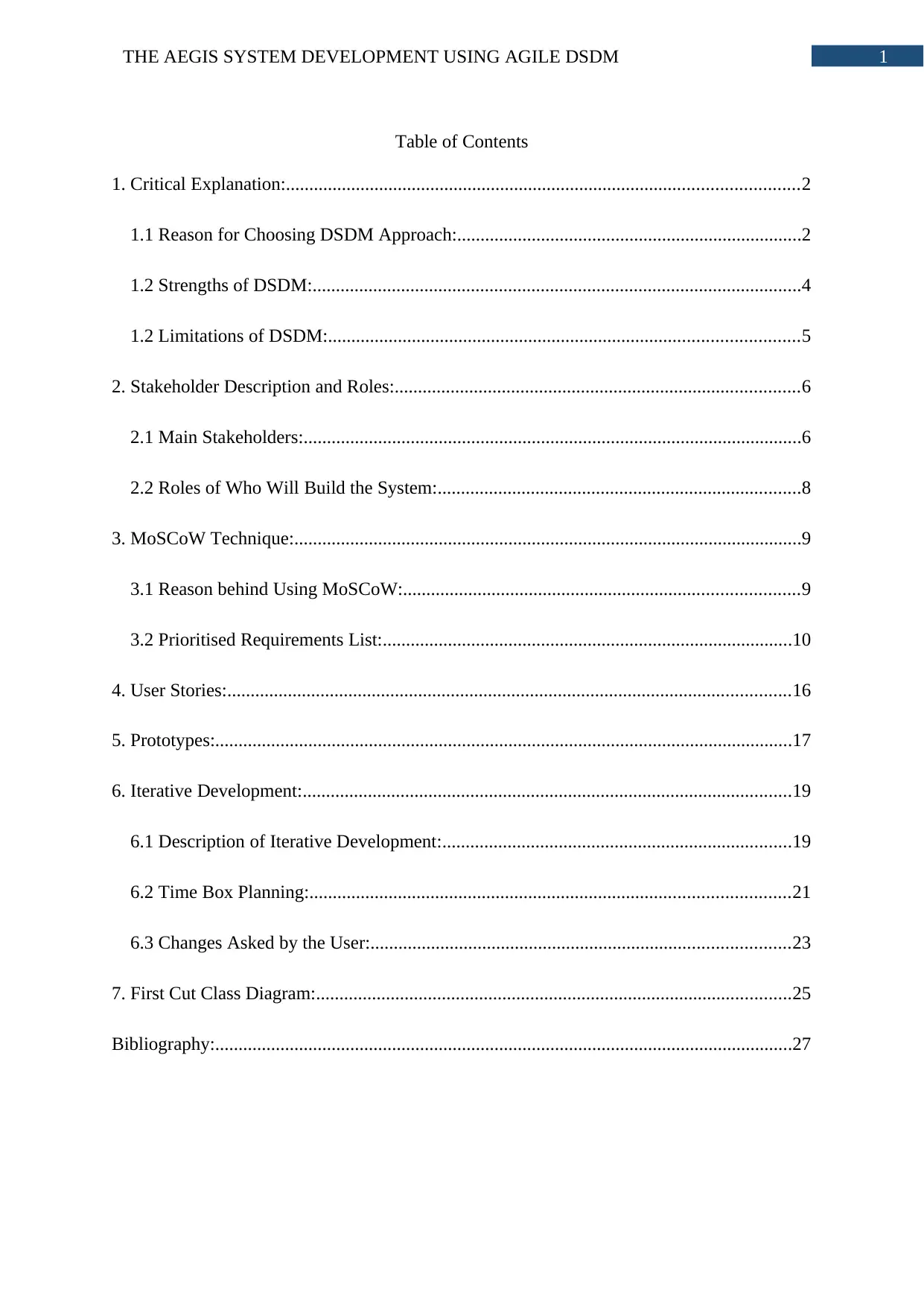
1THE AEGIS SYSTEM DEVELOPMENT USING AGILE DSDM
Table of Contents
1. Critical Explanation:..............................................................................................................2
1.1 Reason for Choosing DSDM Approach:..........................................................................2
1.2 Strengths of DSDM:.........................................................................................................4
1.2 Limitations of DSDM:.....................................................................................................5
2. Stakeholder Description and Roles:.......................................................................................6
2.1 Main Stakeholders:...........................................................................................................6
2.2 Roles of Who Will Build the System:..............................................................................8
3. MoSCoW Technique:.............................................................................................................9
3.1 Reason behind Using MoSCoW:.....................................................................................9
3.2 Prioritised Requirements List:........................................................................................10
4. User Stories:.........................................................................................................................16
5. Prototypes:............................................................................................................................17
6. Iterative Development:.........................................................................................................19
6.1 Description of Iterative Development:...........................................................................19
6.2 Time Box Planning:.......................................................................................................21
6.3 Changes Asked by the User:..........................................................................................23
7. First Cut Class Diagram:......................................................................................................25
Bibliography:............................................................................................................................27
Table of Contents
1. Critical Explanation:..............................................................................................................2
1.1 Reason for Choosing DSDM Approach:..........................................................................2
1.2 Strengths of DSDM:.........................................................................................................4
1.2 Limitations of DSDM:.....................................................................................................5
2. Stakeholder Description and Roles:.......................................................................................6
2.1 Main Stakeholders:...........................................................................................................6
2.2 Roles of Who Will Build the System:..............................................................................8
3. MoSCoW Technique:.............................................................................................................9
3.1 Reason behind Using MoSCoW:.....................................................................................9
3.2 Prioritised Requirements List:........................................................................................10
4. User Stories:.........................................................................................................................16
5. Prototypes:............................................................................................................................17
6. Iterative Development:.........................................................................................................19
6.1 Description of Iterative Development:...........................................................................19
6.2 Time Box Planning:.......................................................................................................21
6.3 Changes Asked by the User:..........................................................................................23
7. First Cut Class Diagram:......................................................................................................25
Bibliography:............................................................................................................................27
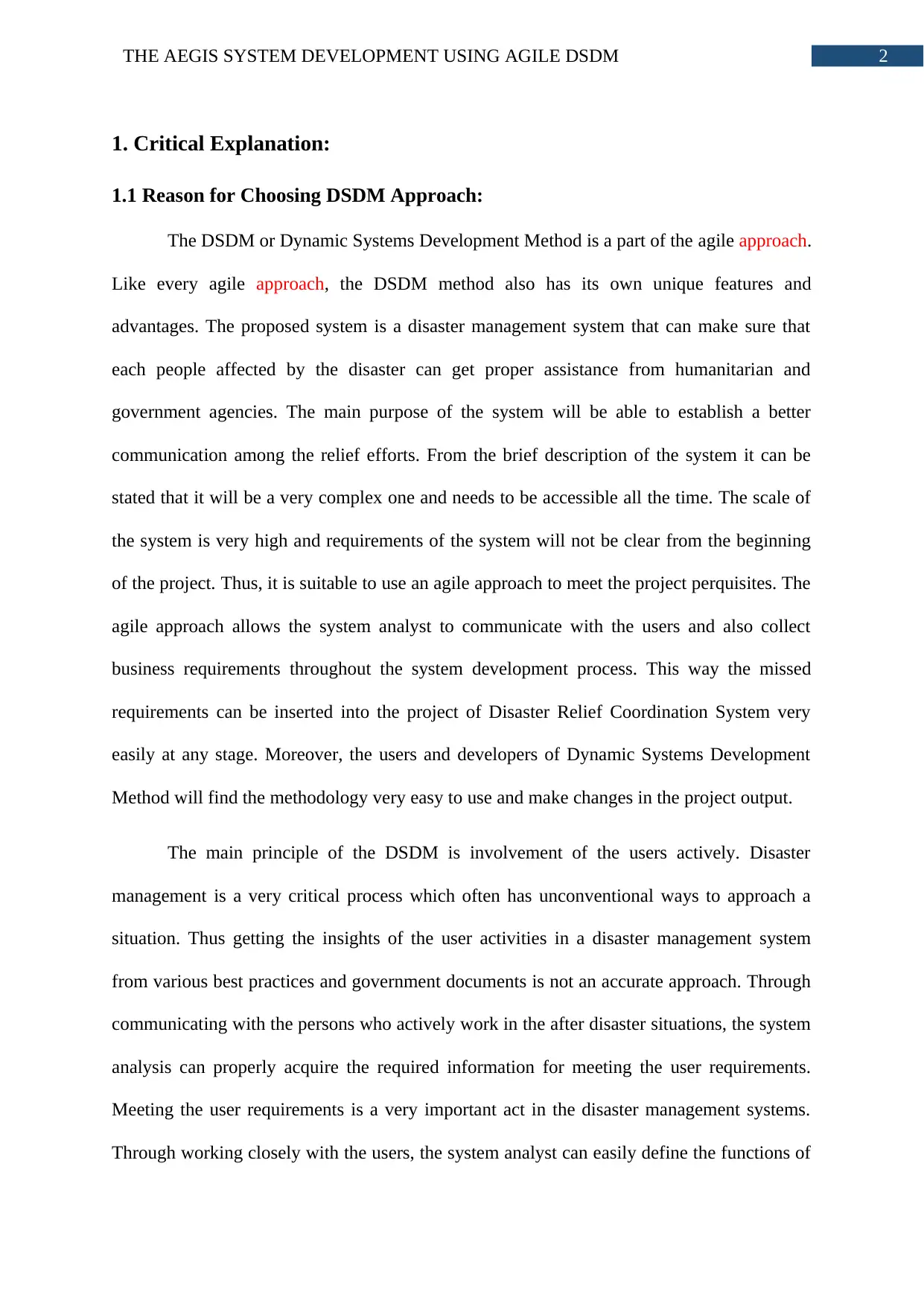
2THE AEGIS SYSTEM DEVELOPMENT USING AGILE DSDM
1. Critical Explanation:
1.1 Reason for Choosing DSDM Approach:
The DSDM or Dynamic Systems Development Method is a part of the agile approach.
Like every agile approach, the DSDM method also has its own unique features and
advantages. The proposed system is a disaster management system that can make sure that
each people affected by the disaster can get proper assistance from humanitarian and
government agencies. The main purpose of the system will be able to establish a better
communication among the relief efforts. From the brief description of the system it can be
stated that it will be a very complex one and needs to be accessible all the time. The scale of
the system is very high and requirements of the system will not be clear from the beginning
of the project. Thus, it is suitable to use an agile approach to meet the project perquisites. The
agile approach allows the system analyst to communicate with the users and also collect
business requirements throughout the system development process. This way the missed
requirements can be inserted into the project of Disaster Relief Coordination System very
easily at any stage. Moreover, the users and developers of Dynamic Systems Development
Method will find the methodology very easy to use and make changes in the project output.
The main principle of the DSDM is involvement of the users actively. Disaster
management is a very critical process which often has unconventional ways to approach a
situation. Thus getting the insights of the user activities in a disaster management system
from various best practices and government documents is not an accurate approach. Through
communicating with the persons who actively work in the after disaster situations, the system
analysis can properly acquire the required information for meeting the user requirements.
Meeting the user requirements is a very important act in the disaster management systems.
Through working closely with the users, the system analyst can easily define the functions of
1. Critical Explanation:
1.1 Reason for Choosing DSDM Approach:
The DSDM or Dynamic Systems Development Method is a part of the agile approach.
Like every agile approach, the DSDM method also has its own unique features and
advantages. The proposed system is a disaster management system that can make sure that
each people affected by the disaster can get proper assistance from humanitarian and
government agencies. The main purpose of the system will be able to establish a better
communication among the relief efforts. From the brief description of the system it can be
stated that it will be a very complex one and needs to be accessible all the time. The scale of
the system is very high and requirements of the system will not be clear from the beginning
of the project. Thus, it is suitable to use an agile approach to meet the project perquisites. The
agile approach allows the system analyst to communicate with the users and also collect
business requirements throughout the system development process. This way the missed
requirements can be inserted into the project of Disaster Relief Coordination System very
easily at any stage. Moreover, the users and developers of Dynamic Systems Development
Method will find the methodology very easy to use and make changes in the project output.
The main principle of the DSDM is involvement of the users actively. Disaster
management is a very critical process which often has unconventional ways to approach a
situation. Thus getting the insights of the user activities in a disaster management system
from various best practices and government documents is not an accurate approach. Through
communicating with the persons who actively work in the after disaster situations, the system
analysis can properly acquire the required information for meeting the user requirements.
Meeting the user requirements is a very important act in the disaster management systems.
Through working closely with the users, the system analyst can easily define the functions of
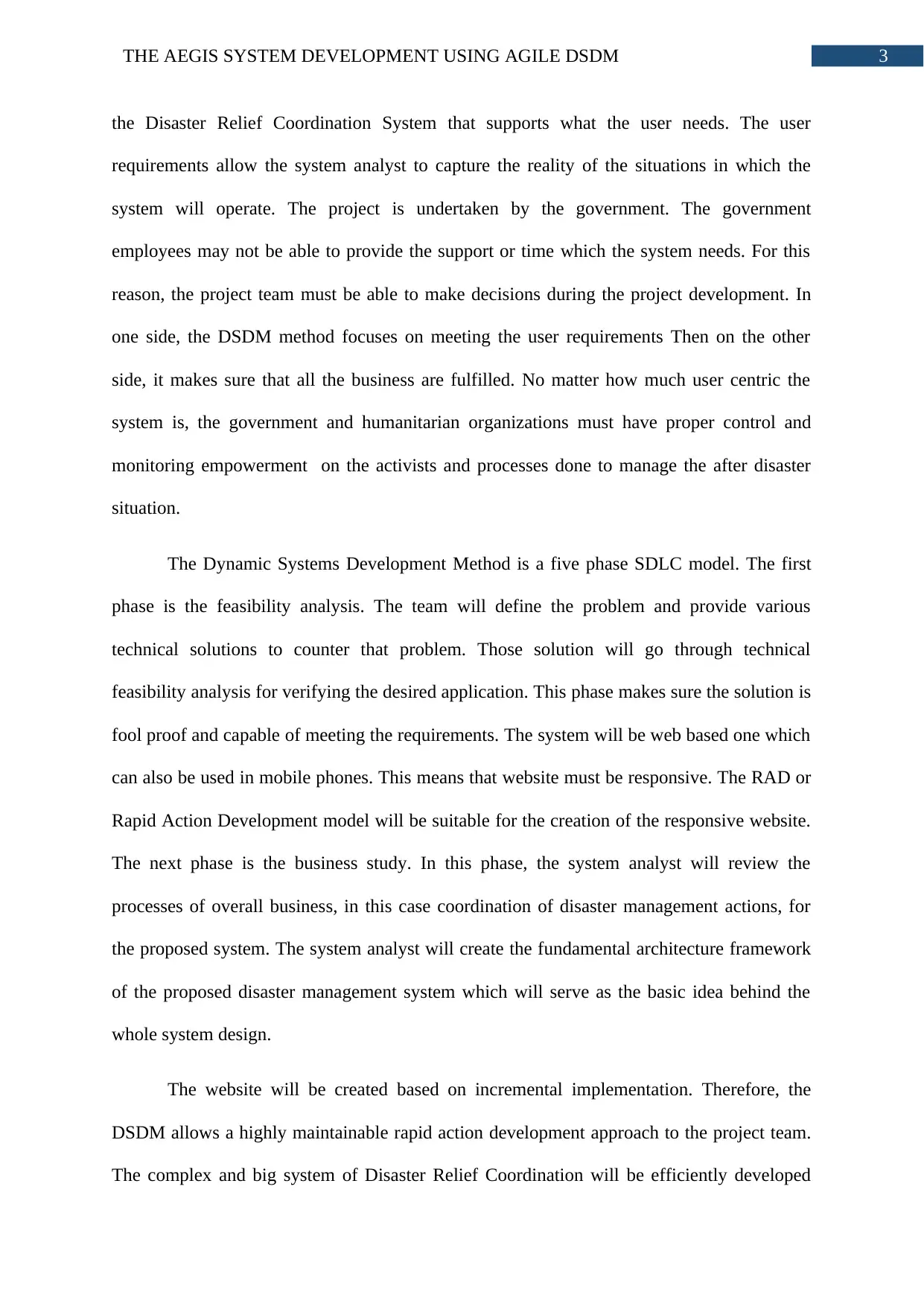
3THE AEGIS SYSTEM DEVELOPMENT USING AGILE DSDM
the Disaster Relief Coordination System that supports what the user needs. The user
requirements allow the system analyst to capture the reality of the situations in which the
system will operate. The project is undertaken by the government. The government
employees may not be able to provide the support or time which the system needs. For this
reason, the project team must be able to make decisions during the project development. In
one side, the DSDM method focuses on meeting the user requirements Then on the other
side, it makes sure that all the business are fulfilled. No matter how much user centric the
system is, the government and humanitarian organizations must have proper control and
monitoring empowerment on the activists and processes done to manage the after disaster
situation.
The Dynamic Systems Development Method is a five phase SDLC model. The first
phase is the feasibility analysis. The team will define the problem and provide various
technical solutions to counter that problem. Those solution will go through technical
feasibility analysis for verifying the desired application. This phase makes sure the solution is
fool proof and capable of meeting the requirements. The system will be web based one which
can also be used in mobile phones. This means that website must be responsive. The RAD or
Rapid Action Development model will be suitable for the creation of the responsive website.
The next phase is the business study. In this phase, the system analyst will review the
processes of overall business, in this case coordination of disaster management actions, for
the proposed system. The system analyst will create the fundamental architecture framework
of the proposed disaster management system which will serve as the basic idea behind the
whole system design.
The website will be created based on incremental implementation. Therefore, the
DSDM allows a highly maintainable rapid action development approach to the project team.
The complex and big system of Disaster Relief Coordination will be efficiently developed
the Disaster Relief Coordination System that supports what the user needs. The user
requirements allow the system analyst to capture the reality of the situations in which the
system will operate. The project is undertaken by the government. The government
employees may not be able to provide the support or time which the system needs. For this
reason, the project team must be able to make decisions during the project development. In
one side, the DSDM method focuses on meeting the user requirements Then on the other
side, it makes sure that all the business are fulfilled. No matter how much user centric the
system is, the government and humanitarian organizations must have proper control and
monitoring empowerment on the activists and processes done to manage the after disaster
situation.
The Dynamic Systems Development Method is a five phase SDLC model. The first
phase is the feasibility analysis. The team will define the problem and provide various
technical solutions to counter that problem. Those solution will go through technical
feasibility analysis for verifying the desired application. This phase makes sure the solution is
fool proof and capable of meeting the requirements. The system will be web based one which
can also be used in mobile phones. This means that website must be responsive. The RAD or
Rapid Action Development model will be suitable for the creation of the responsive website.
The next phase is the business study. In this phase, the system analyst will review the
processes of overall business, in this case coordination of disaster management actions, for
the proposed system. The system analyst will create the fundamental architecture framework
of the proposed disaster management system which will serve as the basic idea behind the
whole system design.
The website will be created based on incremental implementation. Therefore, the
DSDM allows a highly maintainable rapid action development approach to the project team.
The complex and big system of Disaster Relief Coordination will be efficiently developed
Paraphrase This Document
Need a fresh take? Get an instant paraphrase of this document with our AI Paraphraser
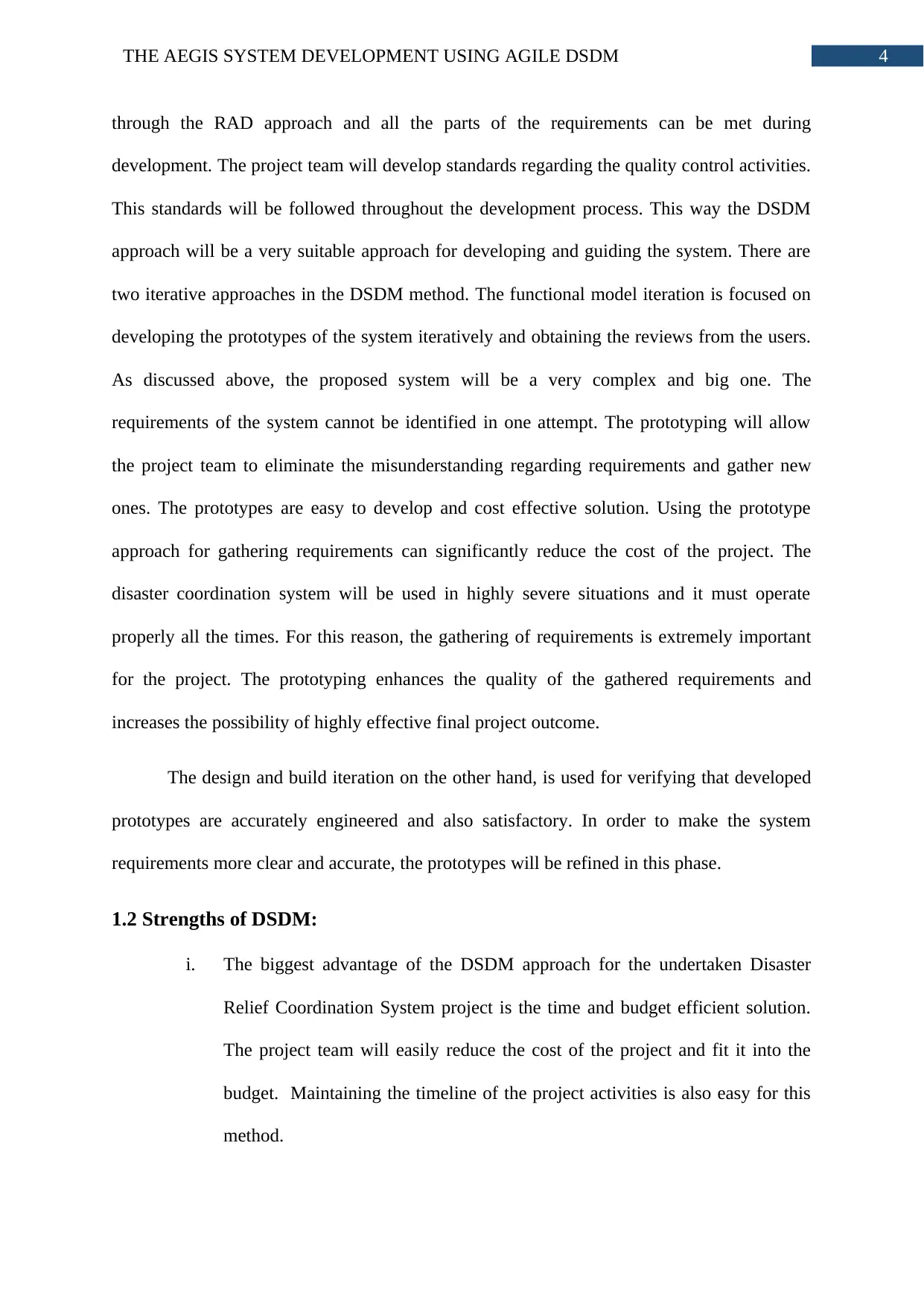
4THE AEGIS SYSTEM DEVELOPMENT USING AGILE DSDM
through the RAD approach and all the parts of the requirements can be met during
development. The project team will develop standards regarding the quality control activities.
This standards will be followed throughout the development process. This way the DSDM
approach will be a very suitable approach for developing and guiding the system. There are
two iterative approaches in the DSDM method. The functional model iteration is focused on
developing the prototypes of the system iteratively and obtaining the reviews from the users.
As discussed above, the proposed system will be a very complex and big one. The
requirements of the system cannot be identified in one attempt. The prototyping will allow
the project team to eliminate the misunderstanding regarding requirements and gather new
ones. The prototypes are easy to develop and cost effective solution. Using the prototype
approach for gathering requirements can significantly reduce the cost of the project. The
disaster coordination system will be used in highly severe situations and it must operate
properly all the times. For this reason, the gathering of requirements is extremely important
for the project. The prototyping enhances the quality of the gathered requirements and
increases the possibility of highly effective final project outcome.
The design and build iteration on the other hand, is used for verifying that developed
prototypes are accurately engineered and also satisfactory. In order to make the system
requirements more clear and accurate, the prototypes will be refined in this phase.
1.2 Strengths of DSDM:
i. The biggest advantage of the DSDM approach for the undertaken Disaster
Relief Coordination System project is the time and budget efficient solution.
The project team will easily reduce the cost of the project and fit it into the
budget. Maintaining the timeline of the project activities is also easy for this
method.
through the RAD approach and all the parts of the requirements can be met during
development. The project team will develop standards regarding the quality control activities.
This standards will be followed throughout the development process. This way the DSDM
approach will be a very suitable approach for developing and guiding the system. There are
two iterative approaches in the DSDM method. The functional model iteration is focused on
developing the prototypes of the system iteratively and obtaining the reviews from the users.
As discussed above, the proposed system will be a very complex and big one. The
requirements of the system cannot be identified in one attempt. The prototyping will allow
the project team to eliminate the misunderstanding regarding requirements and gather new
ones. The prototypes are easy to develop and cost effective solution. Using the prototype
approach for gathering requirements can significantly reduce the cost of the project. The
disaster coordination system will be used in highly severe situations and it must operate
properly all the times. For this reason, the gathering of requirements is extremely important
for the project. The prototyping enhances the quality of the gathered requirements and
increases the possibility of highly effective final project outcome.
The design and build iteration on the other hand, is used for verifying that developed
prototypes are accurately engineered and also satisfactory. In order to make the system
requirements more clear and accurate, the prototypes will be refined in this phase.
1.2 Strengths of DSDM:
i. The biggest advantage of the DSDM approach for the undertaken Disaster
Relief Coordination System project is the time and budget efficient solution.
The project team will easily reduce the cost of the project and fit it into the
budget. Maintaining the timeline of the project activities is also easy for this
method.
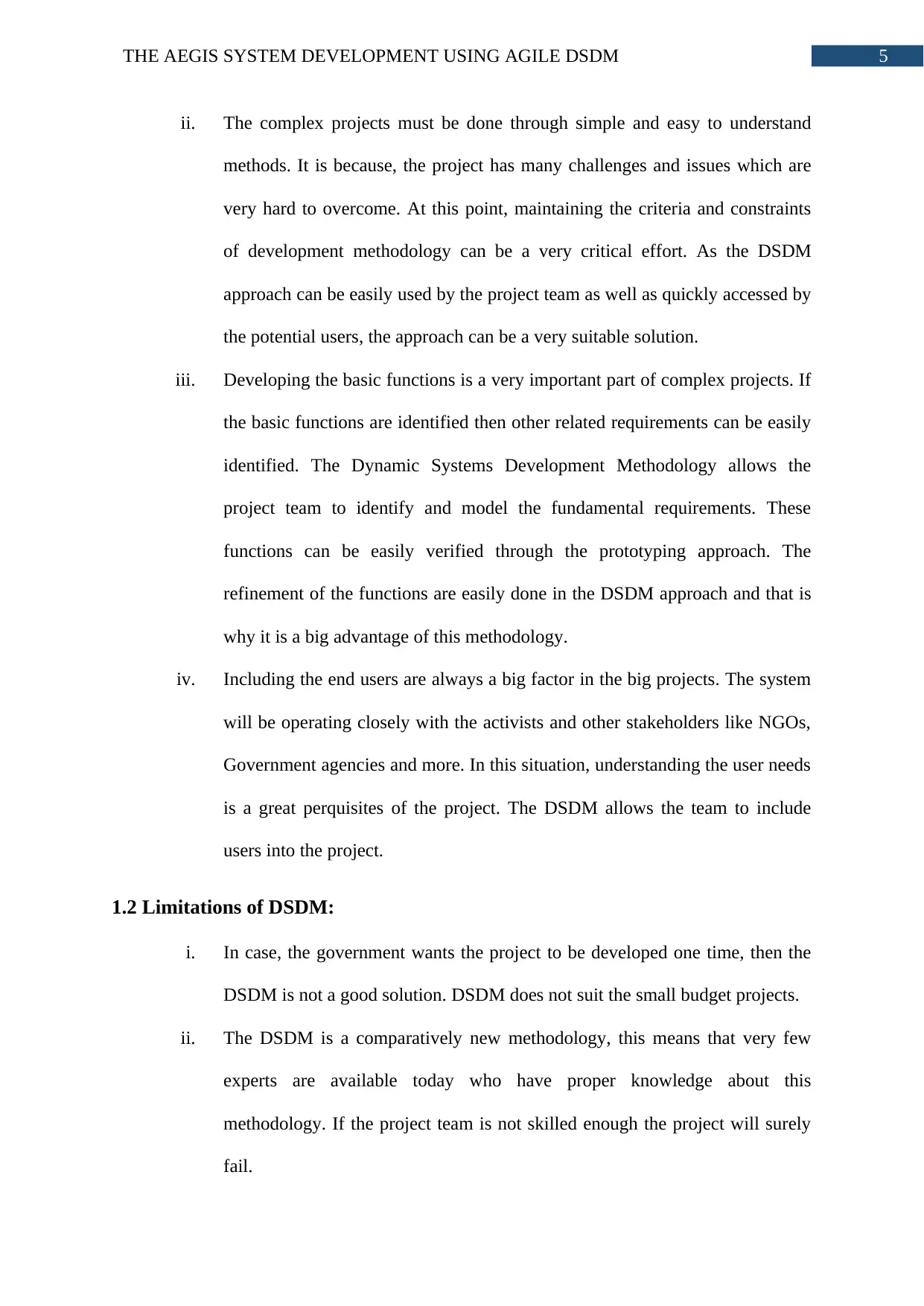
5THE AEGIS SYSTEM DEVELOPMENT USING AGILE DSDM
ii. The complex projects must be done through simple and easy to understand
methods. It is because, the project has many challenges and issues which are
very hard to overcome. At this point, maintaining the criteria and constraints
of development methodology can be a very critical effort. As the DSDM
approach can be easily used by the project team as well as quickly accessed by
the potential users, the approach can be a very suitable solution.
iii. Developing the basic functions is a very important part of complex projects. If
the basic functions are identified then other related requirements can be easily
identified. The Dynamic Systems Development Methodology allows the
project team to identify and model the fundamental requirements. These
functions can be easily verified through the prototyping approach. The
refinement of the functions are easily done in the DSDM approach and that is
why it is a big advantage of this methodology.
iv. Including the end users are always a big factor in the big projects. The system
will be operating closely with the activists and other stakeholders like NGOs,
Government agencies and more. In this situation, understanding the user needs
is a great perquisites of the project. The DSDM allows the team to include
users into the project.
1.2 Limitations of DSDM:
i. In case, the government wants the project to be developed one time, then the
DSDM is not a good solution. DSDM does not suit the small budget projects.
ii. The DSDM is a comparatively new methodology, this means that very few
experts are available today who have proper knowledge about this
methodology. If the project team is not skilled enough the project will surely
fail.
ii. The complex projects must be done through simple and easy to understand
methods. It is because, the project has many challenges and issues which are
very hard to overcome. At this point, maintaining the criteria and constraints
of development methodology can be a very critical effort. As the DSDM
approach can be easily used by the project team as well as quickly accessed by
the potential users, the approach can be a very suitable solution.
iii. Developing the basic functions is a very important part of complex projects. If
the basic functions are identified then other related requirements can be easily
identified. The Dynamic Systems Development Methodology allows the
project team to identify and model the fundamental requirements. These
functions can be easily verified through the prototyping approach. The
refinement of the functions are easily done in the DSDM approach and that is
why it is a big advantage of this methodology.
iv. Including the end users are always a big factor in the big projects. The system
will be operating closely with the activists and other stakeholders like NGOs,
Government agencies and more. In this situation, understanding the user needs
is a great perquisites of the project. The DSDM allows the team to include
users into the project.
1.2 Limitations of DSDM:
i. In case, the government wants the project to be developed one time, then the
DSDM is not a good solution. DSDM does not suit the small budget projects.
ii. The DSDM is a comparatively new methodology, this means that very few
experts are available today who have proper knowledge about this
methodology. If the project team is not skilled enough the project will surely
fail.
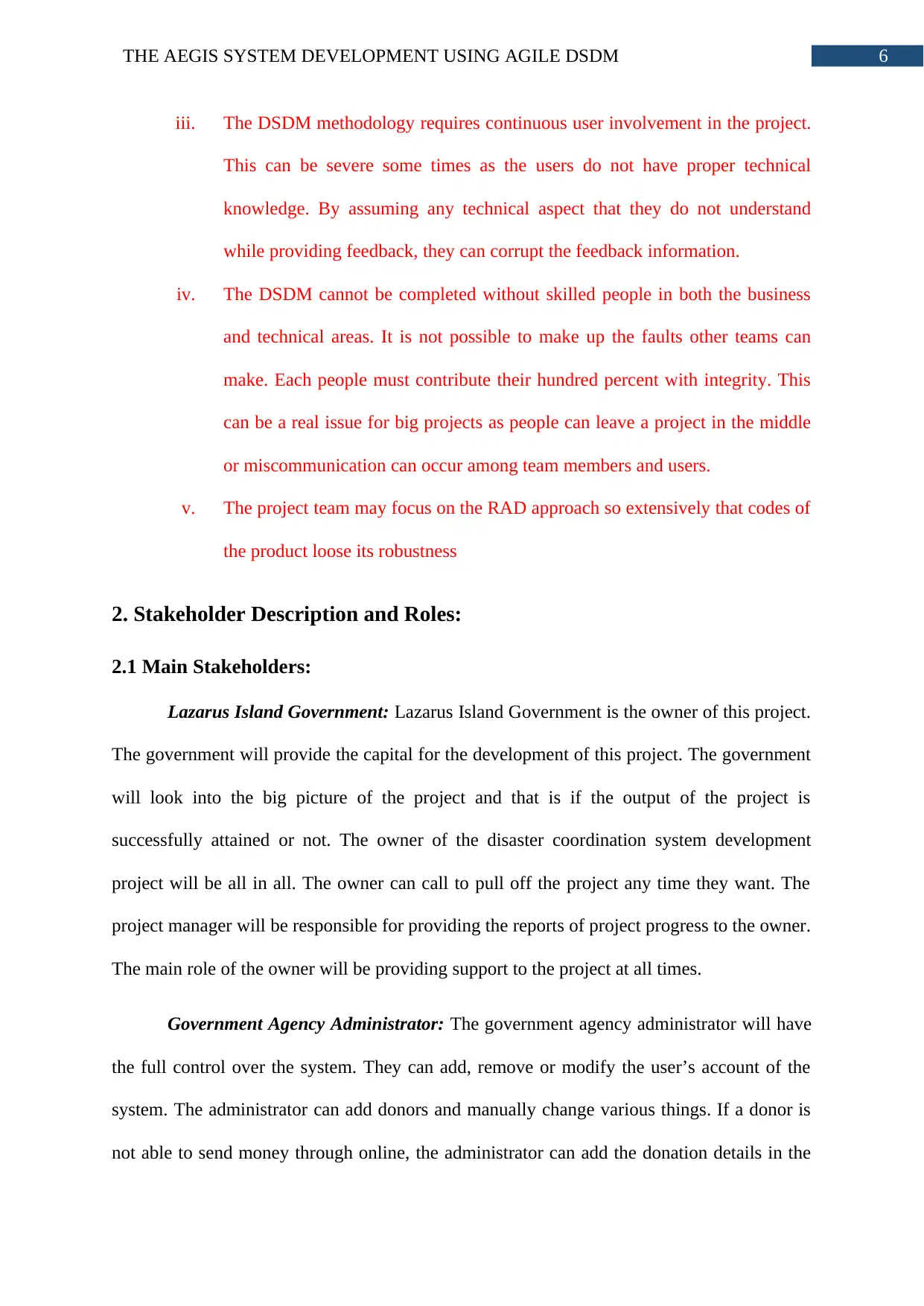
6THE AEGIS SYSTEM DEVELOPMENT USING AGILE DSDM
iii. The DSDM methodology requires continuous user involvement in the project.
This can be severe some times as the users do not have proper technical
knowledge. By assuming any technical aspect that they do not understand
while providing feedback, they can corrupt the feedback information.
iv. The DSDM cannot be completed without skilled people in both the business
and technical areas. It is not possible to make up the faults other teams can
make. Each people must contribute their hundred percent with integrity. This
can be a real issue for big projects as people can leave a project in the middle
or miscommunication can occur among team members and users.
v. The project team may focus on the RAD approach so extensively that codes of
the product loose its robustness
2. Stakeholder Description and Roles:
2.1 Main Stakeholders:
Lazarus Island Government: Lazarus Island Government is the owner of this project.
The government will provide the capital for the development of this project. The government
will look into the big picture of the project and that is if the output of the project is
successfully attained or not. The owner of the disaster coordination system development
project will be all in all. The owner can call to pull off the project any time they want. The
project manager will be responsible for providing the reports of project progress to the owner.
The main role of the owner will be providing support to the project at all times.
Government Agency Administrator: The government agency administrator will have
the full control over the system. They can add, remove or modify the user’s account of the
system. The administrator can add donors and manually change various things. If a donor is
not able to send money through online, the administrator can add the donation details in the
iii. The DSDM methodology requires continuous user involvement in the project.
This can be severe some times as the users do not have proper technical
knowledge. By assuming any technical aspect that they do not understand
while providing feedback, they can corrupt the feedback information.
iv. The DSDM cannot be completed without skilled people in both the business
and technical areas. It is not possible to make up the faults other teams can
make. Each people must contribute their hundred percent with integrity. This
can be a real issue for big projects as people can leave a project in the middle
or miscommunication can occur among team members and users.
v. The project team may focus on the RAD approach so extensively that codes of
the product loose its robustness
2. Stakeholder Description and Roles:
2.1 Main Stakeholders:
Lazarus Island Government: Lazarus Island Government is the owner of this project.
The government will provide the capital for the development of this project. The government
will look into the big picture of the project and that is if the output of the project is
successfully attained or not. The owner of the disaster coordination system development
project will be all in all. The owner can call to pull off the project any time they want. The
project manager will be responsible for providing the reports of project progress to the owner.
The main role of the owner will be providing support to the project at all times.
Government Agency Administrator: The government agency administrator will have
the full control over the system. They can add, remove or modify the user’s account of the
system. The administrator can add donors and manually change various things. If a donor is
not able to send money through online, the administrator can add the donation details in the
Secure Best Marks with AI Grader
Need help grading? Try our AI Grader for instant feedback on your assignments.
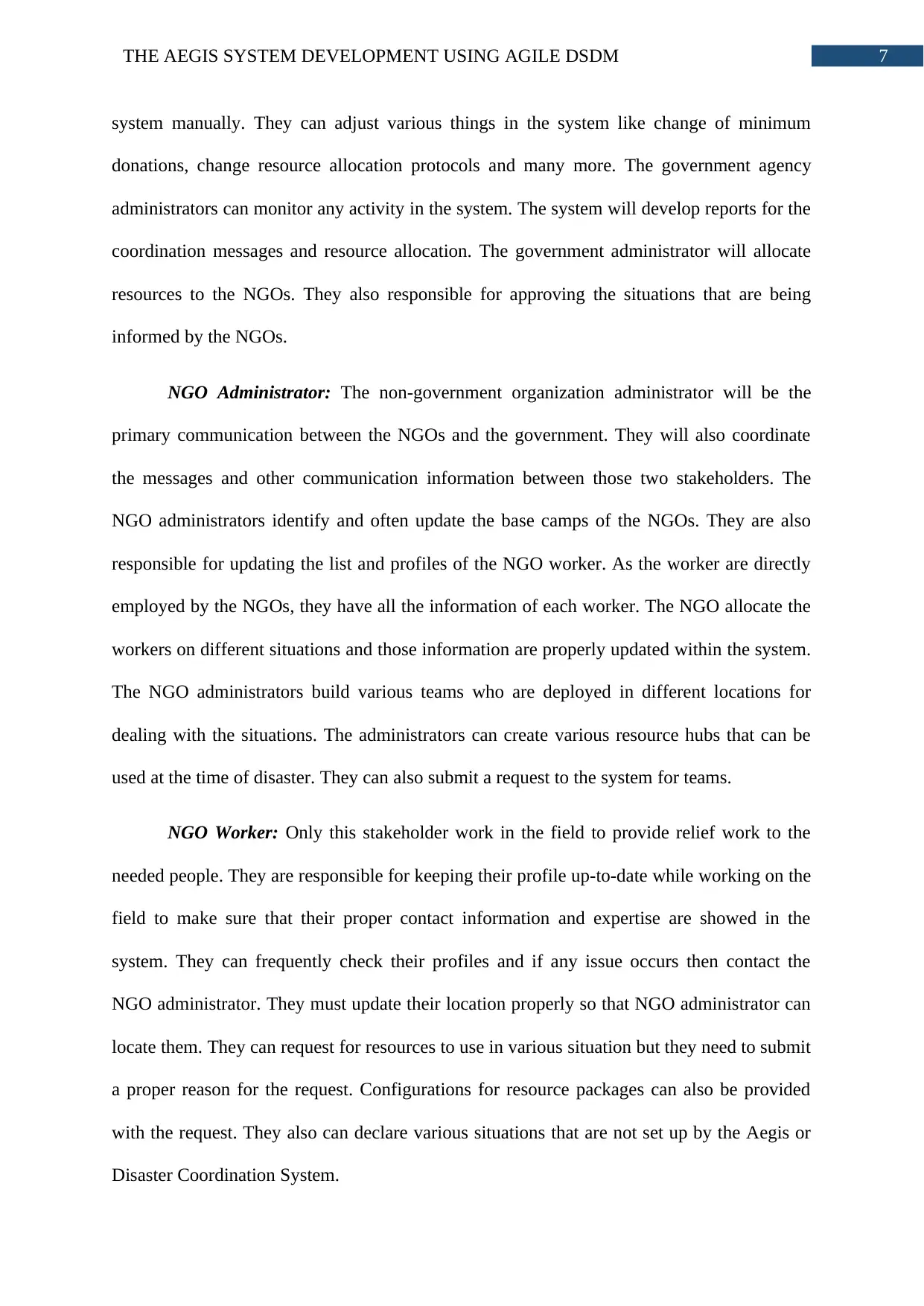
7THE AEGIS SYSTEM DEVELOPMENT USING AGILE DSDM
system manually. They can adjust various things in the system like change of minimum
donations, change resource allocation protocols and many more. The government agency
administrators can monitor any activity in the system. The system will develop reports for the
coordination messages and resource allocation. The government administrator will allocate
resources to the NGOs. They also responsible for approving the situations that are being
informed by the NGOs.
NGO Administrator: The non-government organization administrator will be the
primary communication between the NGOs and the government. They will also coordinate
the messages and other communication information between those two stakeholders. The
NGO administrators identify and often update the base camps of the NGOs. They are also
responsible for updating the list and profiles of the NGO worker. As the worker are directly
employed by the NGOs, they have all the information of each worker. The NGO allocate the
workers on different situations and those information are properly updated within the system.
The NGO administrators build various teams who are deployed in different locations for
dealing with the situations. The administrators can create various resource hubs that can be
used at the time of disaster. They can also submit a request to the system for teams.
NGO Worker: Only this stakeholder work in the field to provide relief work to the
needed people. They are responsible for keeping their profile up-to-date while working on the
field to make sure that their proper contact information and expertise are showed in the
system. They can frequently check their profiles and if any issue occurs then contact the
NGO administrator. They must update their location properly so that NGO administrator can
locate them. They can request for resources to use in various situation but they need to submit
a proper reason for the request. Configurations for resource packages can also be provided
with the request. They also can declare various situations that are not set up by the Aegis or
Disaster Coordination System.
system manually. They can adjust various things in the system like change of minimum
donations, change resource allocation protocols and many more. The government agency
administrators can monitor any activity in the system. The system will develop reports for the
coordination messages and resource allocation. The government administrator will allocate
resources to the NGOs. They also responsible for approving the situations that are being
informed by the NGOs.
NGO Administrator: The non-government organization administrator will be the
primary communication between the NGOs and the government. They will also coordinate
the messages and other communication information between those two stakeholders. The
NGO administrators identify and often update the base camps of the NGOs. They are also
responsible for updating the list and profiles of the NGO worker. As the worker are directly
employed by the NGOs, they have all the information of each worker. The NGO allocate the
workers on different situations and those information are properly updated within the system.
The NGO administrators build various teams who are deployed in different locations for
dealing with the situations. The administrators can create various resource hubs that can be
used at the time of disaster. They can also submit a request to the system for teams.
NGO Worker: Only this stakeholder work in the field to provide relief work to the
needed people. They are responsible for keeping their profile up-to-date while working on the
field to make sure that their proper contact information and expertise are showed in the
system. They can frequently check their profiles and if any issue occurs then contact the
NGO administrator. They must update their location properly so that NGO administrator can
locate them. They can request for resources to use in various situation but they need to submit
a proper reason for the request. Configurations for resource packages can also be provided
with the request. They also can declare various situations that are not set up by the Aegis or
Disaster Coordination System.
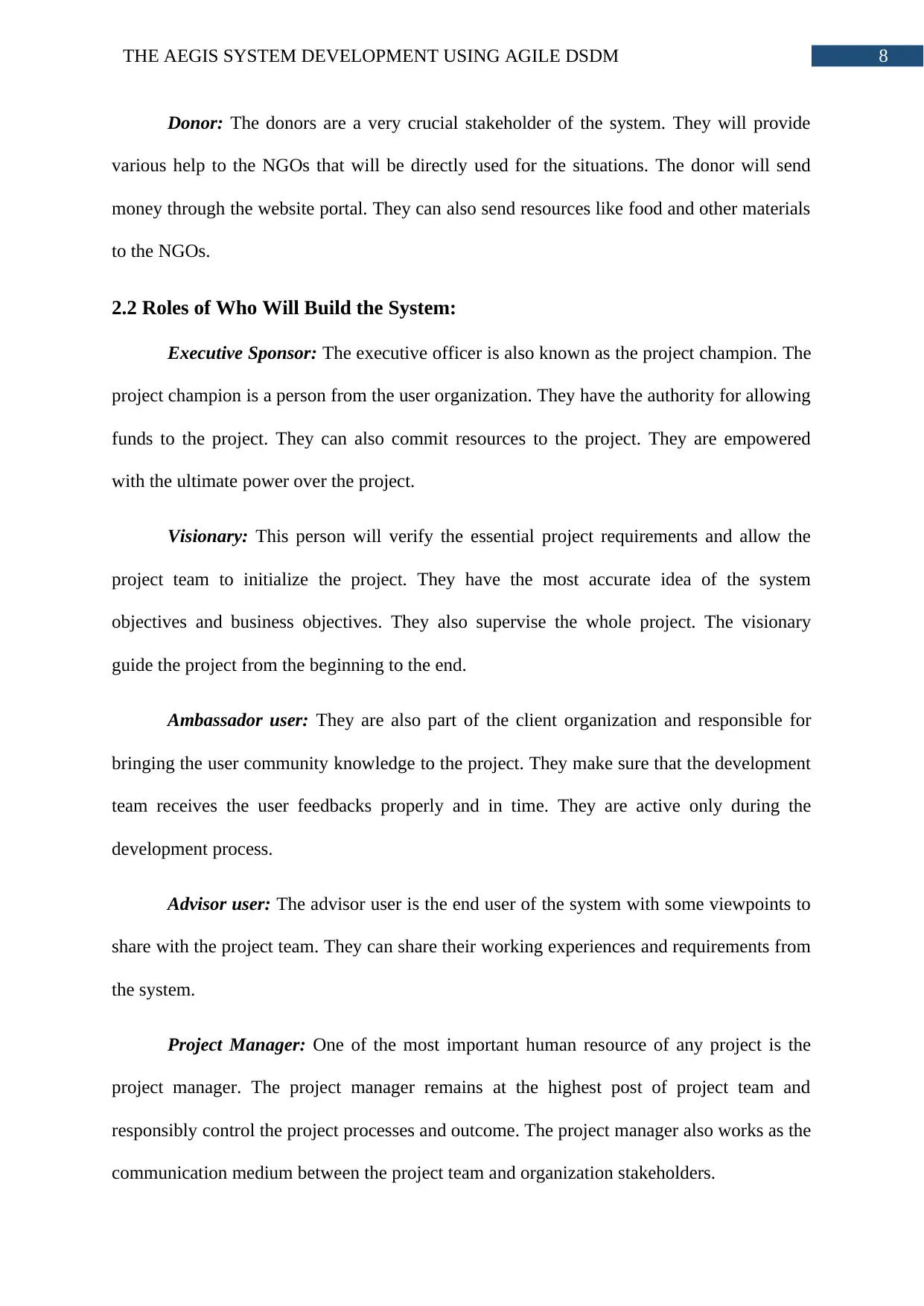
8THE AEGIS SYSTEM DEVELOPMENT USING AGILE DSDM
Donor: The donors are a very crucial stakeholder of the system. They will provide
various help to the NGOs that will be directly used for the situations. The donor will send
money through the website portal. They can also send resources like food and other materials
to the NGOs.
2.2 Roles of Who Will Build the System:
Executive Sponsor: The executive officer is also known as the project champion. The
project champion is a person from the user organization. They have the authority for allowing
funds to the project. They can also commit resources to the project. They are empowered
with the ultimate power over the project.
Visionary: This person will verify the essential project requirements and allow the
project team to initialize the project. They have the most accurate idea of the system
objectives and business objectives. They also supervise the whole project. The visionary
guide the project from the beginning to the end.
Ambassador user: They are also part of the client organization and responsible for
bringing the user community knowledge to the project. They make sure that the development
team receives the user feedbacks properly and in time. They are active only during the
development process.
Advisor user: The advisor user is the end user of the system with some viewpoints to
share with the project team. They can share their working experiences and requirements from
the system.
Project Manager: One of the most important human resource of any project is the
project manager. The project manager remains at the highest post of project team and
responsibly control the project processes and outcome. The project manager also works as the
communication medium between the project team and organization stakeholders.
Donor: The donors are a very crucial stakeholder of the system. They will provide
various help to the NGOs that will be directly used for the situations. The donor will send
money through the website portal. They can also send resources like food and other materials
to the NGOs.
2.2 Roles of Who Will Build the System:
Executive Sponsor: The executive officer is also known as the project champion. The
project champion is a person from the user organization. They have the authority for allowing
funds to the project. They can also commit resources to the project. They are empowered
with the ultimate power over the project.
Visionary: This person will verify the essential project requirements and allow the
project team to initialize the project. They have the most accurate idea of the system
objectives and business objectives. They also supervise the whole project. The visionary
guide the project from the beginning to the end.
Ambassador user: They are also part of the client organization and responsible for
bringing the user community knowledge to the project. They make sure that the development
team receives the user feedbacks properly and in time. They are active only during the
development process.
Advisor user: The advisor user is the end user of the system with some viewpoints to
share with the project team. They can share their working experiences and requirements from
the system.
Project Manager: One of the most important human resource of any project is the
project manager. The project manager remains at the highest post of project team and
responsibly control the project processes and outcome. The project manager also works as the
communication medium between the project team and organization stakeholders.
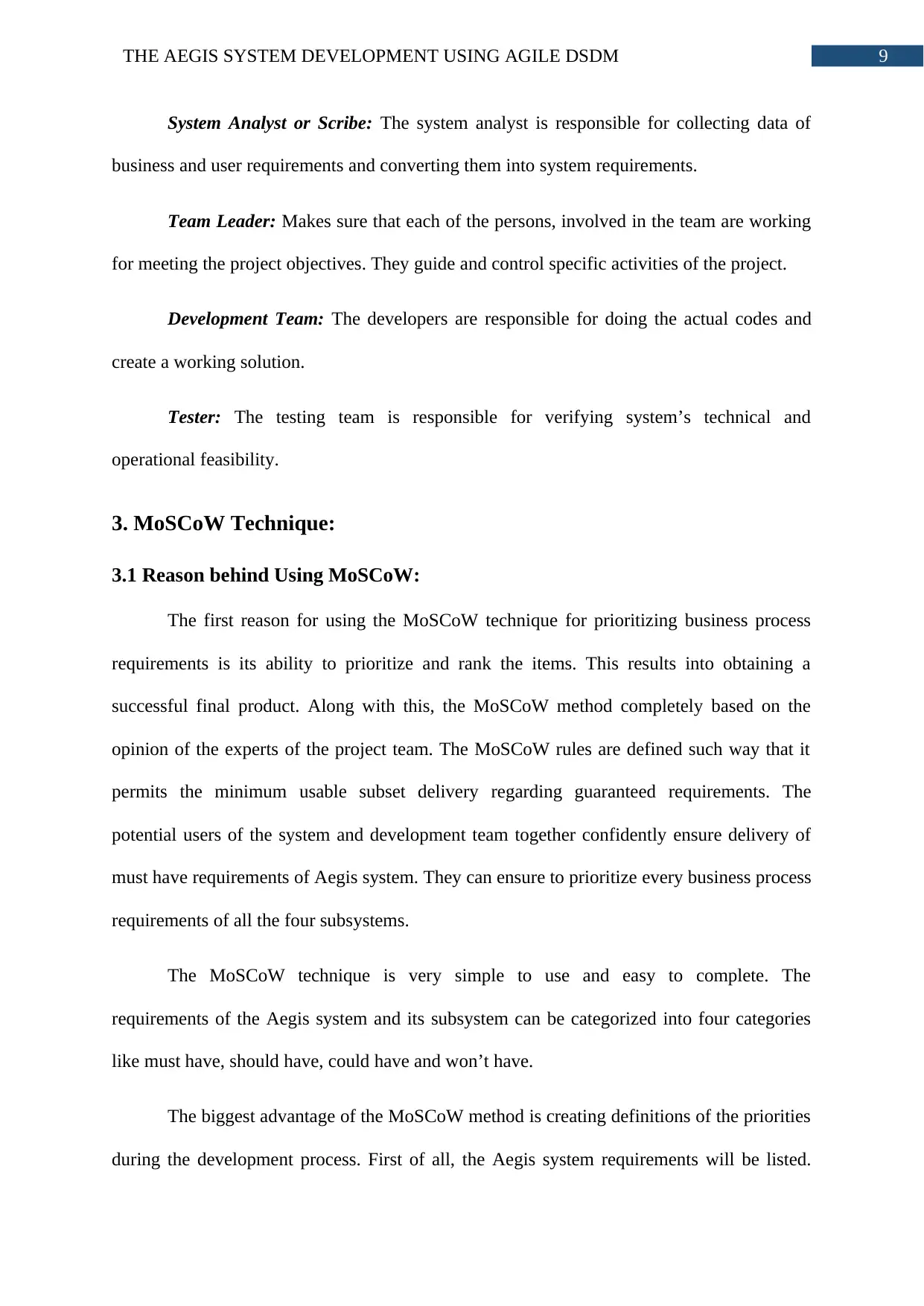
9THE AEGIS SYSTEM DEVELOPMENT USING AGILE DSDM
System Analyst or Scribe: The system analyst is responsible for collecting data of
business and user requirements and converting them into system requirements.
Team Leader: Makes sure that each of the persons, involved in the team are working
for meeting the project objectives. They guide and control specific activities of the project.
Development Team: The developers are responsible for doing the actual codes and
create a working solution.
Tester: The testing team is responsible for verifying system’s technical and
operational feasibility.
3. MoSCoW Technique:
3.1 Reason behind Using MoSCoW:
The first reason for using the MoSCoW technique for prioritizing business process
requirements is its ability to prioritize and rank the items. This results into obtaining a
successful final product. Along with this, the MoSCoW method completely based on the
opinion of the experts of the project team. The MoSCoW rules are defined such way that it
permits the minimum usable subset delivery regarding guaranteed requirements. The
potential users of the system and development team together confidently ensure delivery of
must have requirements of Aegis system. They can ensure to prioritize every business process
requirements of all the four subsystems.
The MoSCoW technique is very simple to use and easy to complete. The
requirements of the Aegis system and its subsystem can be categorized into four categories
like must have, should have, could have and won’t have.
The biggest advantage of the MoSCoW method is creating definitions of the priorities
during the development process. First of all, the Aegis system requirements will be listed.
System Analyst or Scribe: The system analyst is responsible for collecting data of
business and user requirements and converting them into system requirements.
Team Leader: Makes sure that each of the persons, involved in the team are working
for meeting the project objectives. They guide and control specific activities of the project.
Development Team: The developers are responsible for doing the actual codes and
create a working solution.
Tester: The testing team is responsible for verifying system’s technical and
operational feasibility.
3. MoSCoW Technique:
3.1 Reason behind Using MoSCoW:
The first reason for using the MoSCoW technique for prioritizing business process
requirements is its ability to prioritize and rank the items. This results into obtaining a
successful final product. Along with this, the MoSCoW method completely based on the
opinion of the experts of the project team. The MoSCoW rules are defined such way that it
permits the minimum usable subset delivery regarding guaranteed requirements. The
potential users of the system and development team together confidently ensure delivery of
must have requirements of Aegis system. They can ensure to prioritize every business process
requirements of all the four subsystems.
The MoSCoW technique is very simple to use and easy to complete. The
requirements of the Aegis system and its subsystem can be categorized into four categories
like must have, should have, could have and won’t have.
The biggest advantage of the MoSCoW method is creating definitions of the priorities
during the development process. First of all, the Aegis system requirements will be listed.
Paraphrase This Document
Need a fresh take? Get an instant paraphrase of this document with our AI Paraphraser
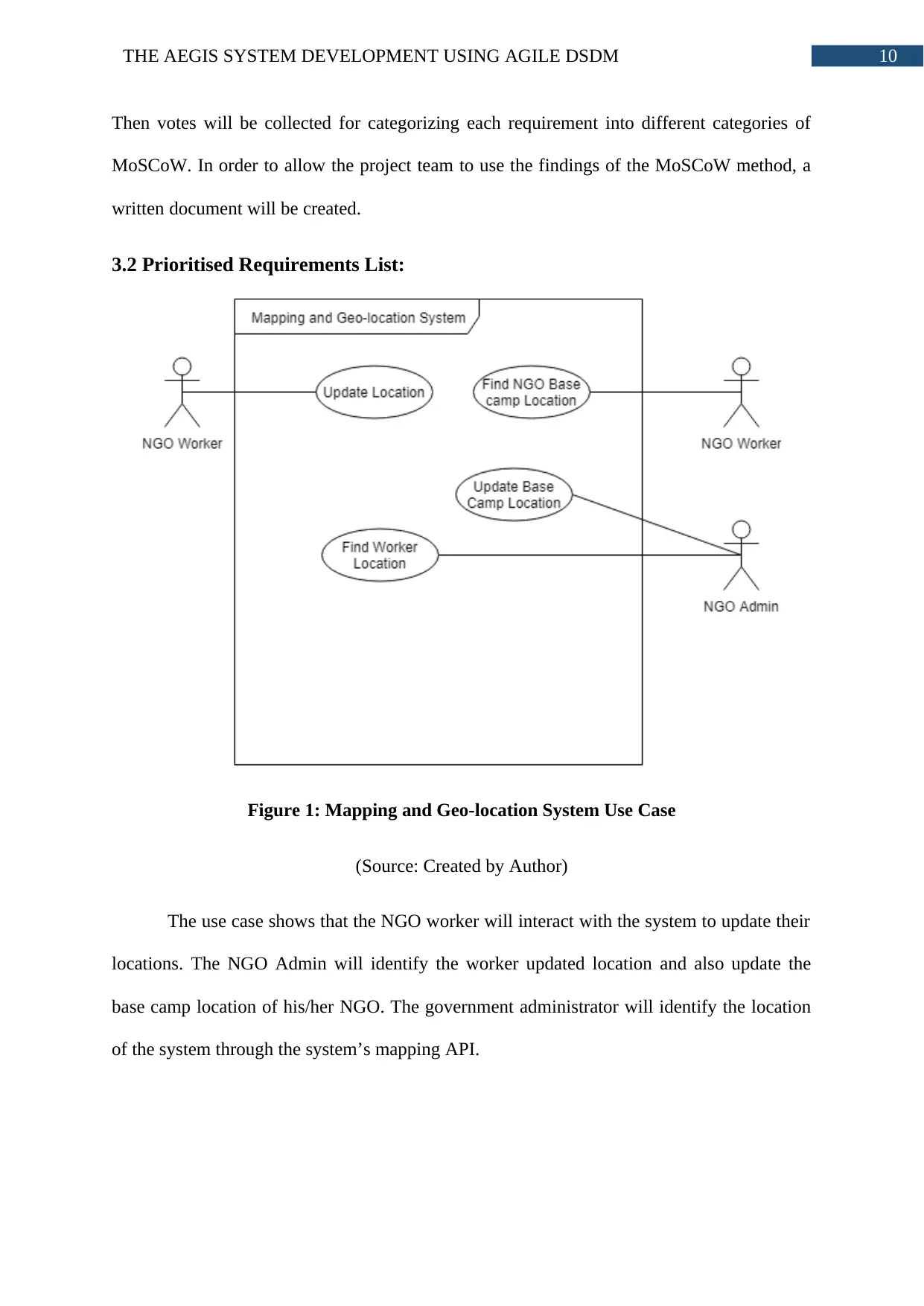
10THE AEGIS SYSTEM DEVELOPMENT USING AGILE DSDM
Then votes will be collected for categorizing each requirement into different categories of
MoSCoW. In order to allow the project team to use the findings of the MoSCoW method, a
written document will be created.
3.2 Prioritised Requirements List:
Figure 1: Mapping and Geo-location System Use Case
(Source: Created by Author)
The use case shows that the NGO worker will interact with the system to update their
locations. The NGO Admin will identify the worker updated location and also update the
base camp location of his/her NGO. The government administrator will identify the location
of the system through the system’s mapping API.
Then votes will be collected for categorizing each requirement into different categories of
MoSCoW. In order to allow the project team to use the findings of the MoSCoW method, a
written document will be created.
3.2 Prioritised Requirements List:
Figure 1: Mapping and Geo-location System Use Case
(Source: Created by Author)
The use case shows that the NGO worker will interact with the system to update their
locations. The NGO Admin will identify the worker updated location and also update the
base camp location of his/her NGO. The government administrator will identify the location
of the system through the system’s mapping API.
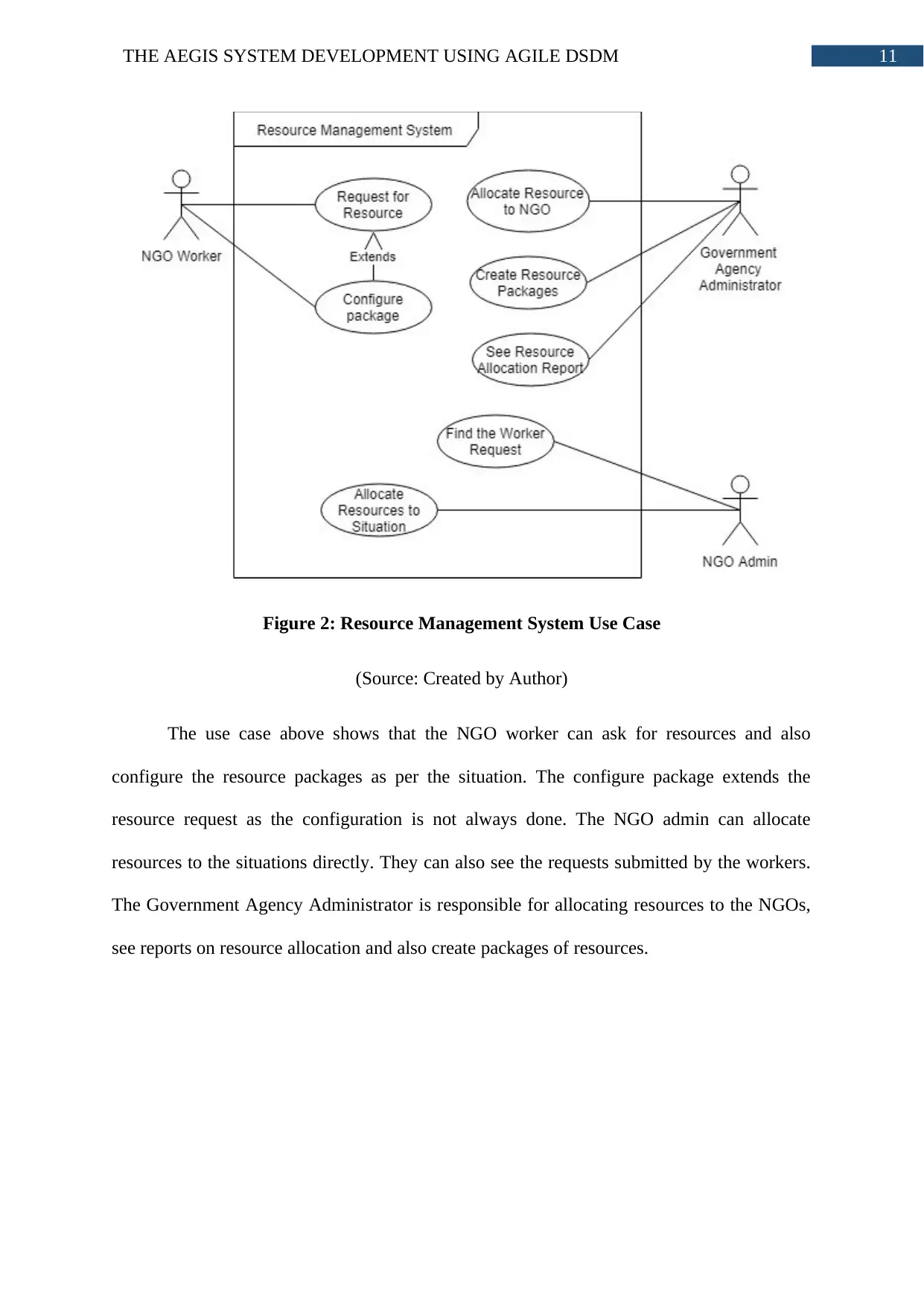
11THE AEGIS SYSTEM DEVELOPMENT USING AGILE DSDM
Figure 2: Resource Management System Use Case
(Source: Created by Author)
The use case above shows that the NGO worker can ask for resources and also
configure the resource packages as per the situation. The configure package extends the
resource request as the configuration is not always done. The NGO admin can allocate
resources to the situations directly. They can also see the requests submitted by the workers.
The Government Agency Administrator is responsible for allocating resources to the NGOs,
see reports on resource allocation and also create packages of resources.
Figure 2: Resource Management System Use Case
(Source: Created by Author)
The use case above shows that the NGO worker can ask for resources and also
configure the resource packages as per the situation. The configure package extends the
resource request as the configuration is not always done. The NGO admin can allocate
resources to the situations directly. They can also see the requests submitted by the workers.
The Government Agency Administrator is responsible for allocating resources to the NGOs,
see reports on resource allocation and also create packages of resources.
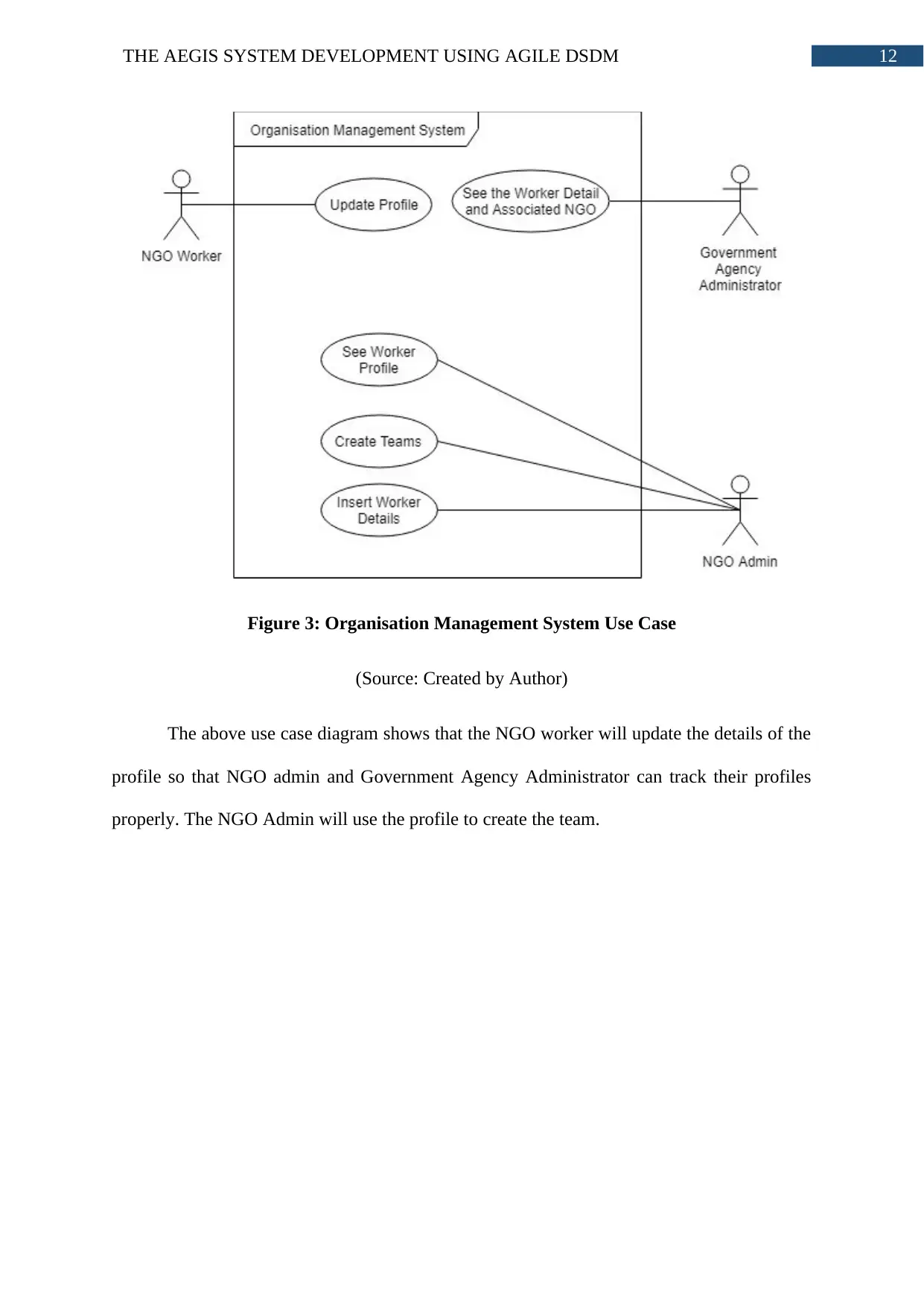
12THE AEGIS SYSTEM DEVELOPMENT USING AGILE DSDM
Figure 3: Organisation Management System Use Case
(Source: Created by Author)
The above use case diagram shows that the NGO worker will update the details of the
profile so that NGO admin and Government Agency Administrator can track their profiles
properly. The NGO Admin will use the profile to create the team.
Figure 3: Organisation Management System Use Case
(Source: Created by Author)
The above use case diagram shows that the NGO worker will update the details of the
profile so that NGO admin and Government Agency Administrator can track their profiles
properly. The NGO Admin will use the profile to create the team.
Secure Best Marks with AI Grader
Need help grading? Try our AI Grader for instant feedback on your assignments.
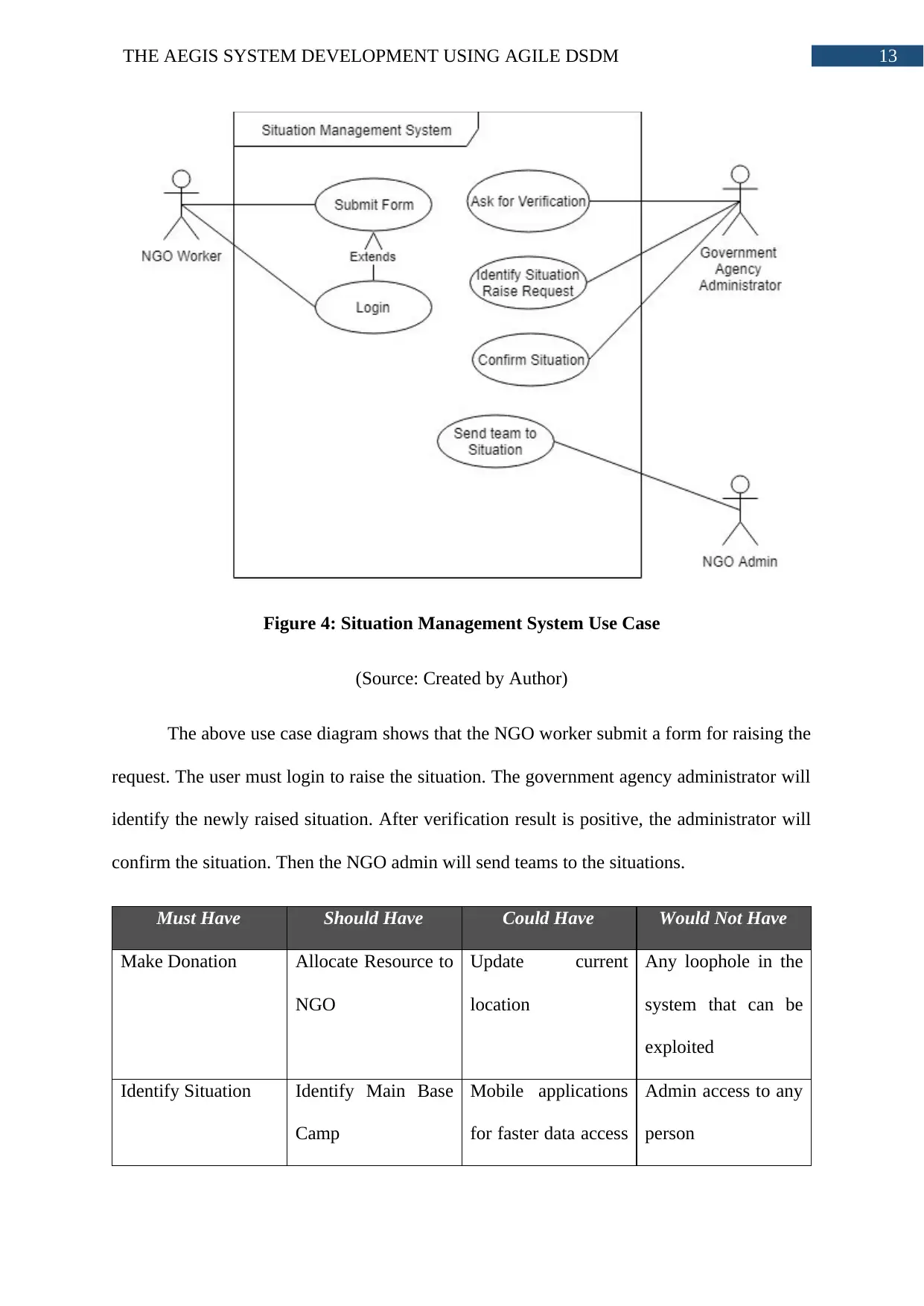
13THE AEGIS SYSTEM DEVELOPMENT USING AGILE DSDM
Figure 4: Situation Management System Use Case
(Source: Created by Author)
The above use case diagram shows that the NGO worker submit a form for raising the
request. The user must login to raise the situation. The government agency administrator will
identify the newly raised situation. After verification result is positive, the administrator will
confirm the situation. Then the NGO admin will send teams to the situations.
Must Have Should Have Could Have Would Not Have
Make Donation Allocate Resource to
NGO
Update current
location
Any loophole in the
system that can be
exploited
Identify Situation Identify Main Base
Camp
Mobile applications
for faster data access
Admin access to any
person
Figure 4: Situation Management System Use Case
(Source: Created by Author)
The above use case diagram shows that the NGO worker submit a form for raising the
request. The user must login to raise the situation. The government agency administrator will
identify the newly raised situation. After verification result is positive, the administrator will
confirm the situation. Then the NGO admin will send teams to the situations.
Must Have Should Have Could Have Would Not Have
Make Donation Allocate Resource to
NGO
Update current
location
Any loophole in the
system that can be
exploited
Identify Situation Identify Main Base
Camp
Mobile applications
for faster data access
Admin access to any
person
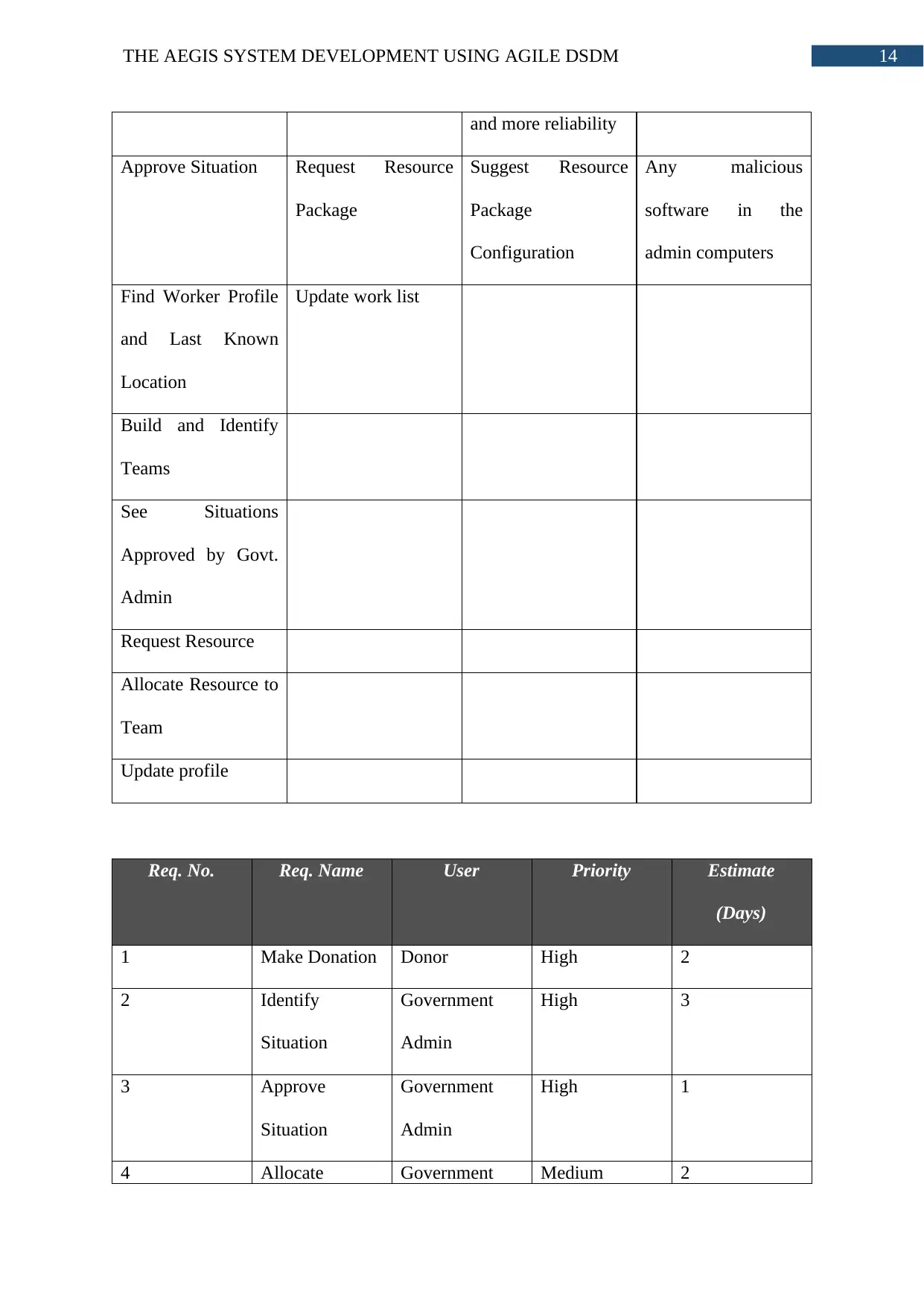
14THE AEGIS SYSTEM DEVELOPMENT USING AGILE DSDM
and more reliability
Approve Situation Request Resource
Package
Suggest Resource
Package
Configuration
Any malicious
software in the
admin computers
Find Worker Profile
and Last Known
Location
Update work list
Build and Identify
Teams
See Situations
Approved by Govt.
Admin
Request Resource
Allocate Resource to
Team
Update profile
Req. No. Req. Name User Priority Estimate
(Days)
1 Make Donation Donor High 2
2 Identify
Situation
Government
Admin
High 3
3 Approve
Situation
Government
Admin
High 1
4 Allocate Government Medium 2
and more reliability
Approve Situation Request Resource
Package
Suggest Resource
Package
Configuration
Any malicious
software in the
admin computers
Find Worker Profile
and Last Known
Location
Update work list
Build and Identify
Teams
See Situations
Approved by Govt.
Admin
Request Resource
Allocate Resource to
Team
Update profile
Req. No. Req. Name User Priority Estimate
(Days)
1 Make Donation Donor High 2
2 Identify
Situation
Government
Admin
High 3
3 Approve
Situation
Government
Admin
High 1
4 Allocate Government Medium 2
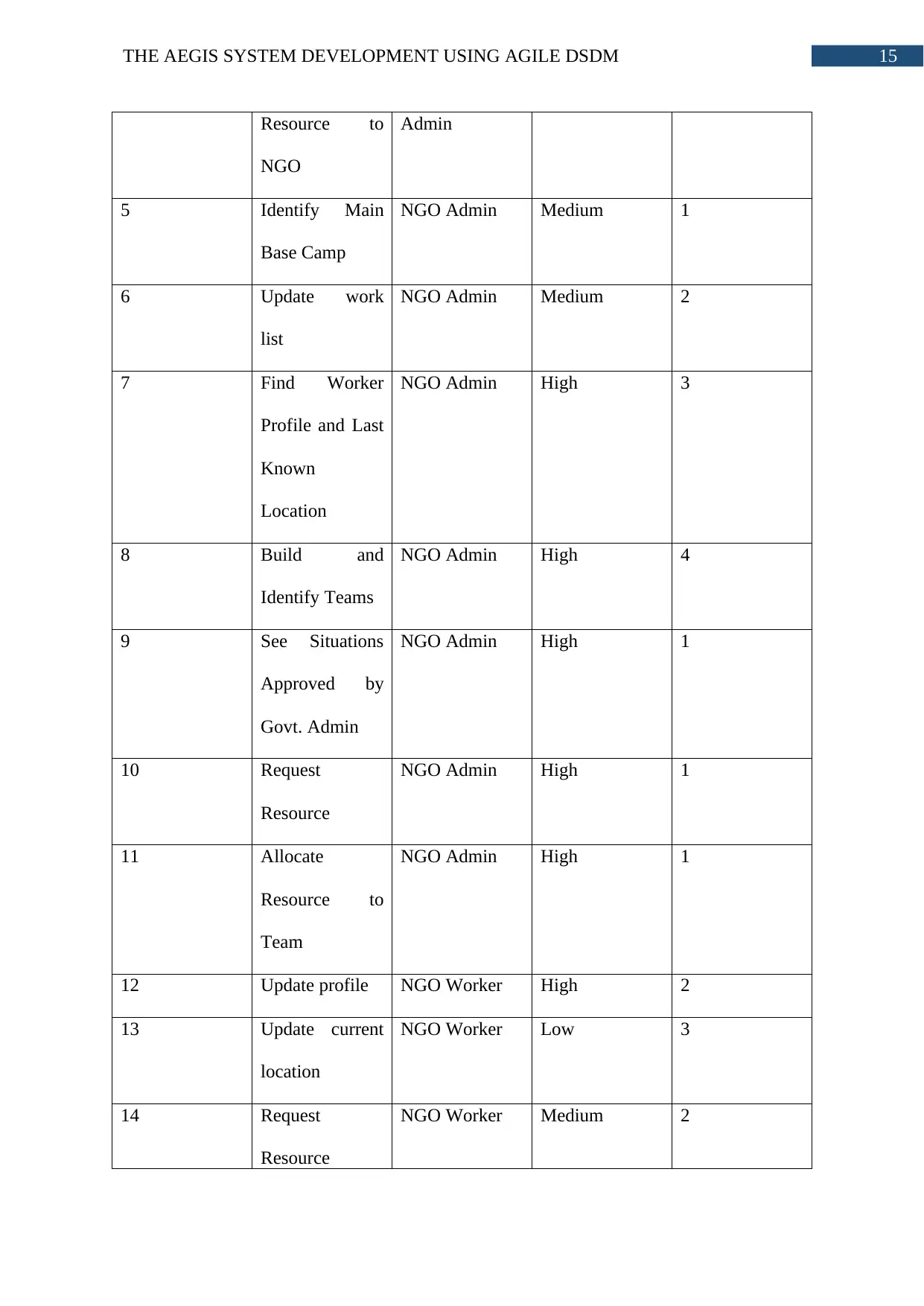
15THE AEGIS SYSTEM DEVELOPMENT USING AGILE DSDM
Resource to
NGO
Admin
5 Identify Main
Base Camp
NGO Admin Medium 1
6 Update work
list
NGO Admin Medium 2
7 Find Worker
Profile and Last
Known
Location
NGO Admin High 3
8 Build and
Identify Teams
NGO Admin High 4
9 See Situations
Approved by
Govt. Admin
NGO Admin High 1
10 Request
Resource
NGO Admin High 1
11 Allocate
Resource to
Team
NGO Admin High 1
12 Update profile NGO Worker High 2
13 Update current
location
NGO Worker Low 3
14 Request
Resource
NGO Worker Medium 2
Resource to
NGO
Admin
5 Identify Main
Base Camp
NGO Admin Medium 1
6 Update work
list
NGO Admin Medium 2
7 Find Worker
Profile and Last
Known
Location
NGO Admin High 3
8 Build and
Identify Teams
NGO Admin High 4
9 See Situations
Approved by
Govt. Admin
NGO Admin High 1
10 Request
Resource
NGO Admin High 1
11 Allocate
Resource to
Team
NGO Admin High 1
12 Update profile NGO Worker High 2
13 Update current
location
NGO Worker Low 3
14 Request
Resource
NGO Worker Medium 2
Paraphrase This Document
Need a fresh take? Get an instant paraphrase of this document with our AI Paraphraser

16THE AEGIS SYSTEM DEVELOPMENT USING AGILE DSDM
Package
15 Suggest
Resource
Package
Configuration
NGO Worker Low 1
4. User Stories:
User Story 1: As a Government Agency Administrator, I want to full access over the
details of any NGO so that I can properly monitor their activities and resource allocation
status to prevent misuse of resources.
Acceptance Criteria: The system will allow only the Government Agency
Administrator to access which NGO has which resources in different locations. It will
generate a report based on the resources distributed by the NGO and Government to specific
situation.
User Story 2: As a NGO worker, I want to update my locations and the profile data
such as expertise as soon as I move from one location to another so that I can keep my
location and profile data updated to inform the NGO in which area I am in right now.
Acceptance Criteria: The system will include well known mapping API that can
support any geographical location no matter how small the area is. The users can easily enter
a location and then manually shift the pint to update exact location.
User Story 2: As a NGO Admin I want to create teams so that can send to various
situations identified the government and raised by others.
Package
15 Suggest
Resource
Package
Configuration
NGO Worker Low 1
4. User Stories:
User Story 1: As a Government Agency Administrator, I want to full access over the
details of any NGO so that I can properly monitor their activities and resource allocation
status to prevent misuse of resources.
Acceptance Criteria: The system will allow only the Government Agency
Administrator to access which NGO has which resources in different locations. It will
generate a report based on the resources distributed by the NGO and Government to specific
situation.
User Story 2: As a NGO worker, I want to update my locations and the profile data
such as expertise as soon as I move from one location to another so that I can keep my
location and profile data updated to inform the NGO in which area I am in right now.
Acceptance Criteria: The system will include well known mapping API that can
support any geographical location no matter how small the area is. The users can easily enter
a location and then manually shift the pint to update exact location.
User Story 2: As a NGO Admin I want to create teams so that can send to various
situations identified the government and raised by others.
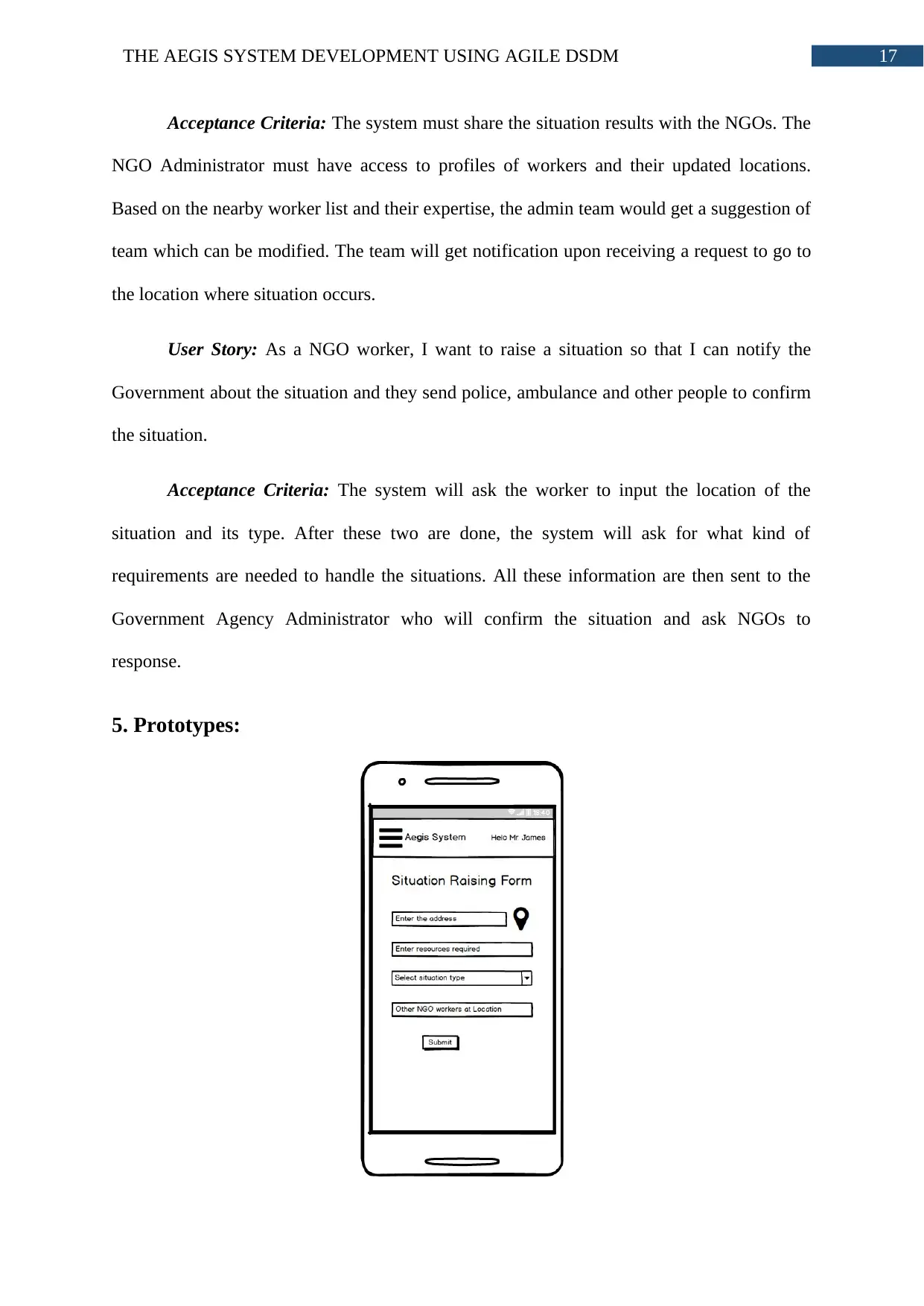
17THE AEGIS SYSTEM DEVELOPMENT USING AGILE DSDM
Acceptance Criteria: The system must share the situation results with the NGOs. The
NGO Administrator must have access to profiles of workers and their updated locations.
Based on the nearby worker list and their expertise, the admin team would get a suggestion of
team which can be modified. The team will get notification upon receiving a request to go to
the location where situation occurs.
User Story: As a NGO worker, I want to raise a situation so that I can notify the
Government about the situation and they send police, ambulance and other people to confirm
the situation.
Acceptance Criteria: The system will ask the worker to input the location of the
situation and its type. After these two are done, the system will ask for what kind of
requirements are needed to handle the situations. All these information are then sent to the
Government Agency Administrator who will confirm the situation and ask NGOs to
response.
5. Prototypes:
Acceptance Criteria: The system must share the situation results with the NGOs. The
NGO Administrator must have access to profiles of workers and their updated locations.
Based on the nearby worker list and their expertise, the admin team would get a suggestion of
team which can be modified. The team will get notification upon receiving a request to go to
the location where situation occurs.
User Story: As a NGO worker, I want to raise a situation so that I can notify the
Government about the situation and they send police, ambulance and other people to confirm
the situation.
Acceptance Criteria: The system will ask the worker to input the location of the
situation and its type. After these two are done, the system will ask for what kind of
requirements are needed to handle the situations. All these information are then sent to the
Government Agency Administrator who will confirm the situation and ask NGOs to
response.
5. Prototypes:
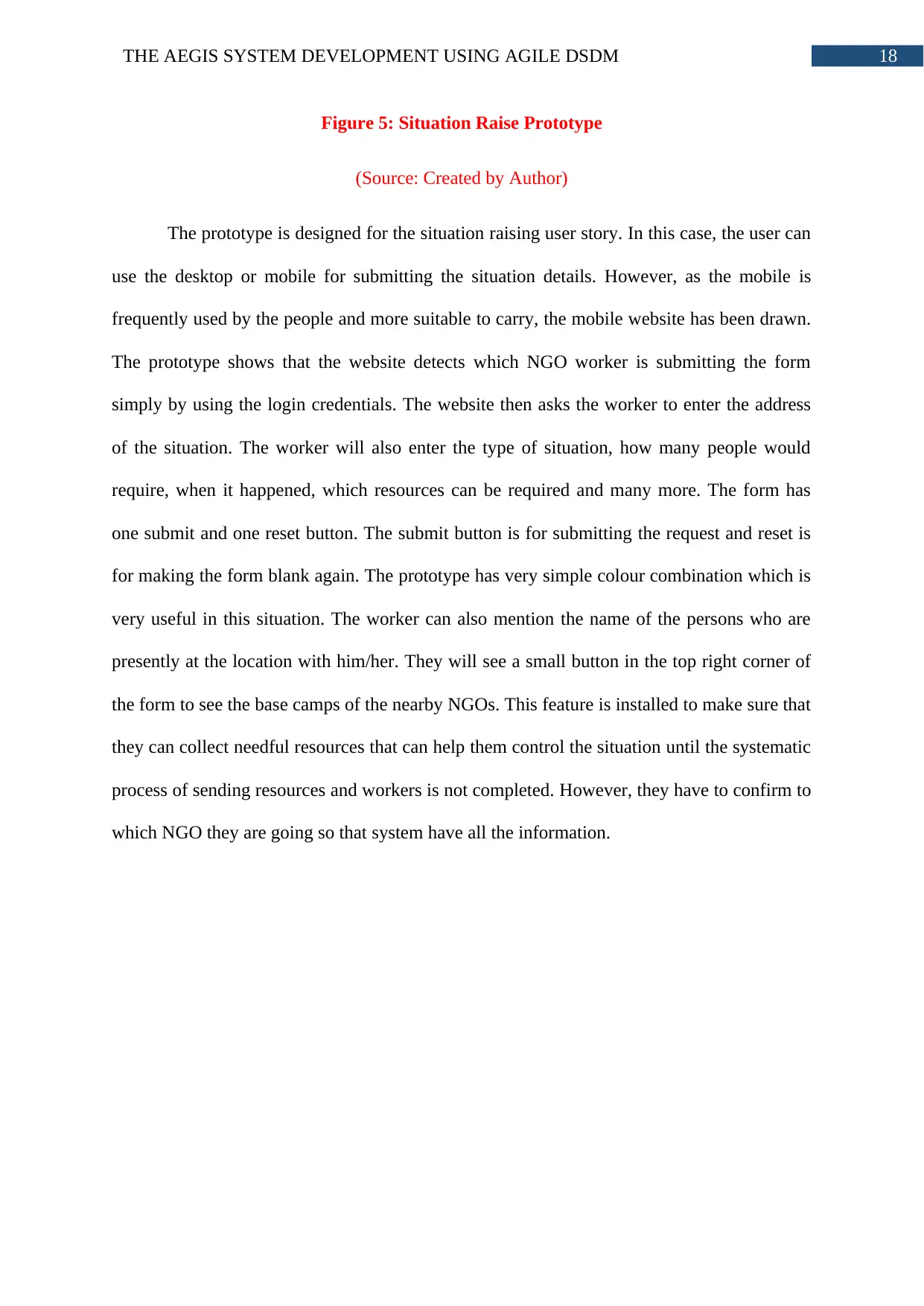
18THE AEGIS SYSTEM DEVELOPMENT USING AGILE DSDM
Figure 5: Situation Raise Prototype
(Source: Created by Author)
The prototype is designed for the situation raising user story. In this case, the user can
use the desktop or mobile for submitting the situation details. However, as the mobile is
frequently used by the people and more suitable to carry, the mobile website has been drawn.
The prototype shows that the website detects which NGO worker is submitting the form
simply by using the login credentials. The website then asks the worker to enter the address
of the situation. The worker will also enter the type of situation, how many people would
require, when it happened, which resources can be required and many more. The form has
one submit and one reset button. The submit button is for submitting the request and reset is
for making the form blank again. The prototype has very simple colour combination which is
very useful in this situation. The worker can also mention the name of the persons who are
presently at the location with him/her. They will see a small button in the top right corner of
the form to see the base camps of the nearby NGOs. This feature is installed to make sure that
they can collect needful resources that can help them control the situation until the systematic
process of sending resources and workers is not completed. However, they have to confirm to
which NGO they are going so that system have all the information.
Figure 5: Situation Raise Prototype
(Source: Created by Author)
The prototype is designed for the situation raising user story. In this case, the user can
use the desktop or mobile for submitting the situation details. However, as the mobile is
frequently used by the people and more suitable to carry, the mobile website has been drawn.
The prototype shows that the website detects which NGO worker is submitting the form
simply by using the login credentials. The website then asks the worker to enter the address
of the situation. The worker will also enter the type of situation, how many people would
require, when it happened, which resources can be required and many more. The form has
one submit and one reset button. The submit button is for submitting the request and reset is
for making the form blank again. The prototype has very simple colour combination which is
very useful in this situation. The worker can also mention the name of the persons who are
presently at the location with him/her. They will see a small button in the top right corner of
the form to see the base camps of the nearby NGOs. This feature is installed to make sure that
they can collect needful resources that can help them control the situation until the systematic
process of sending resources and workers is not completed. However, they have to confirm to
which NGO they are going so that system have all the information.
Secure Best Marks with AI Grader
Need help grading? Try our AI Grader for instant feedback on your assignments.
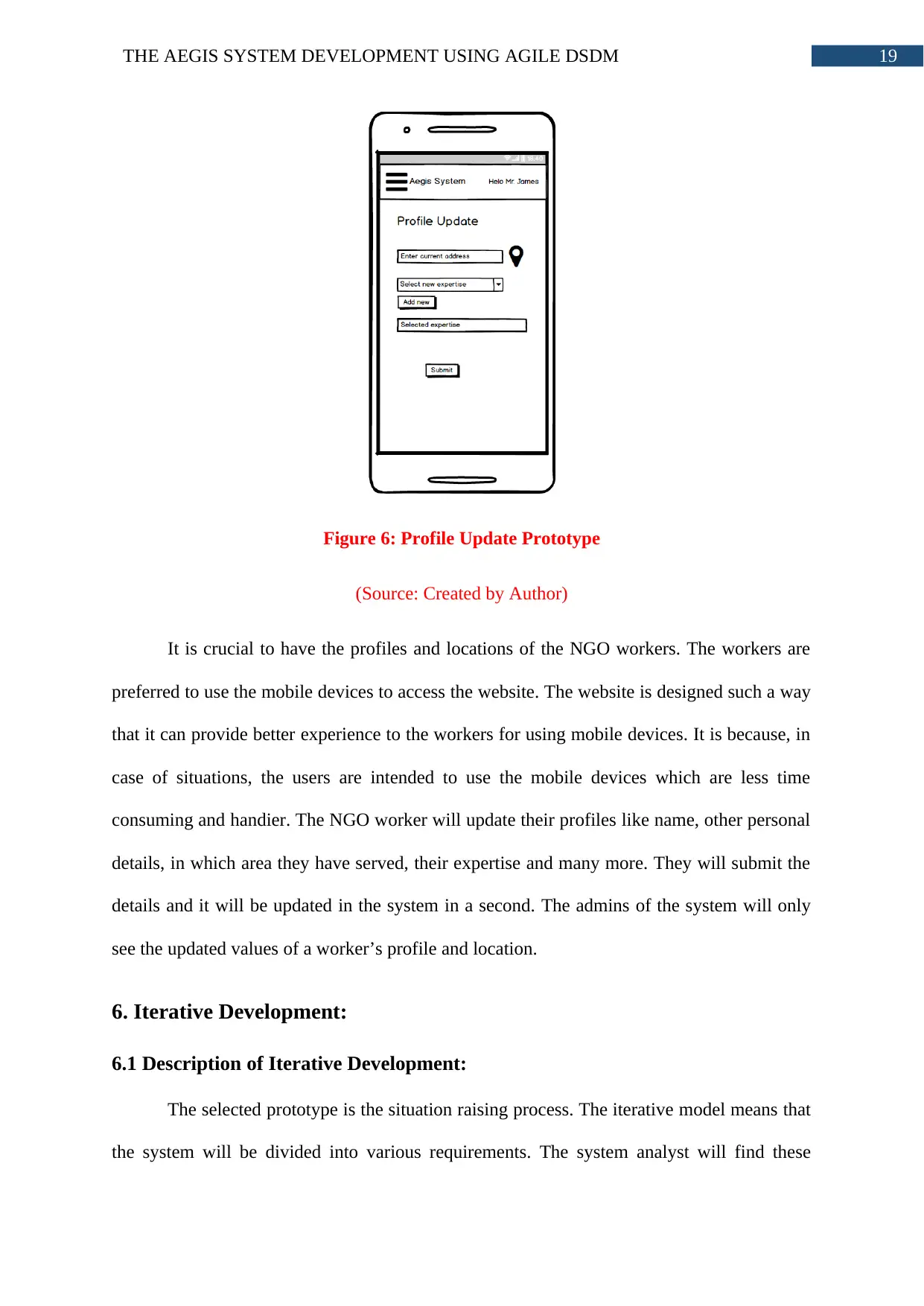
19THE AEGIS SYSTEM DEVELOPMENT USING AGILE DSDM
Figure 6: Profile Update Prototype
(Source: Created by Author)
It is crucial to have the profiles and locations of the NGO workers. The workers are
preferred to use the mobile devices to access the website. The website is designed such a way
that it can provide better experience to the workers for using mobile devices. It is because, in
case of situations, the users are intended to use the mobile devices which are less time
consuming and handier. The NGO worker will update their profiles like name, other personal
details, in which area they have served, their expertise and many more. They will submit the
details and it will be updated in the system in a second. The admins of the system will only
see the updated values of a worker’s profile and location.
6. Iterative Development:
6.1 Description of Iterative Development:
The selected prototype is the situation raising process. The iterative model means that
the system will be divided into various requirements. The system analyst will find these
Figure 6: Profile Update Prototype
(Source: Created by Author)
It is crucial to have the profiles and locations of the NGO workers. The workers are
preferred to use the mobile devices to access the website. The website is designed such a way
that it can provide better experience to the workers for using mobile devices. It is because, in
case of situations, the users are intended to use the mobile devices which are less time
consuming and handier. The NGO worker will update their profiles like name, other personal
details, in which area they have served, their expertise and many more. They will submit the
details and it will be updated in the system in a second. The admins of the system will only
see the updated values of a worker’s profile and location.
6. Iterative Development:
6.1 Description of Iterative Development:
The selected prototype is the situation raising process. The iterative model means that
the system will be divided into various requirements. The system analyst will find these
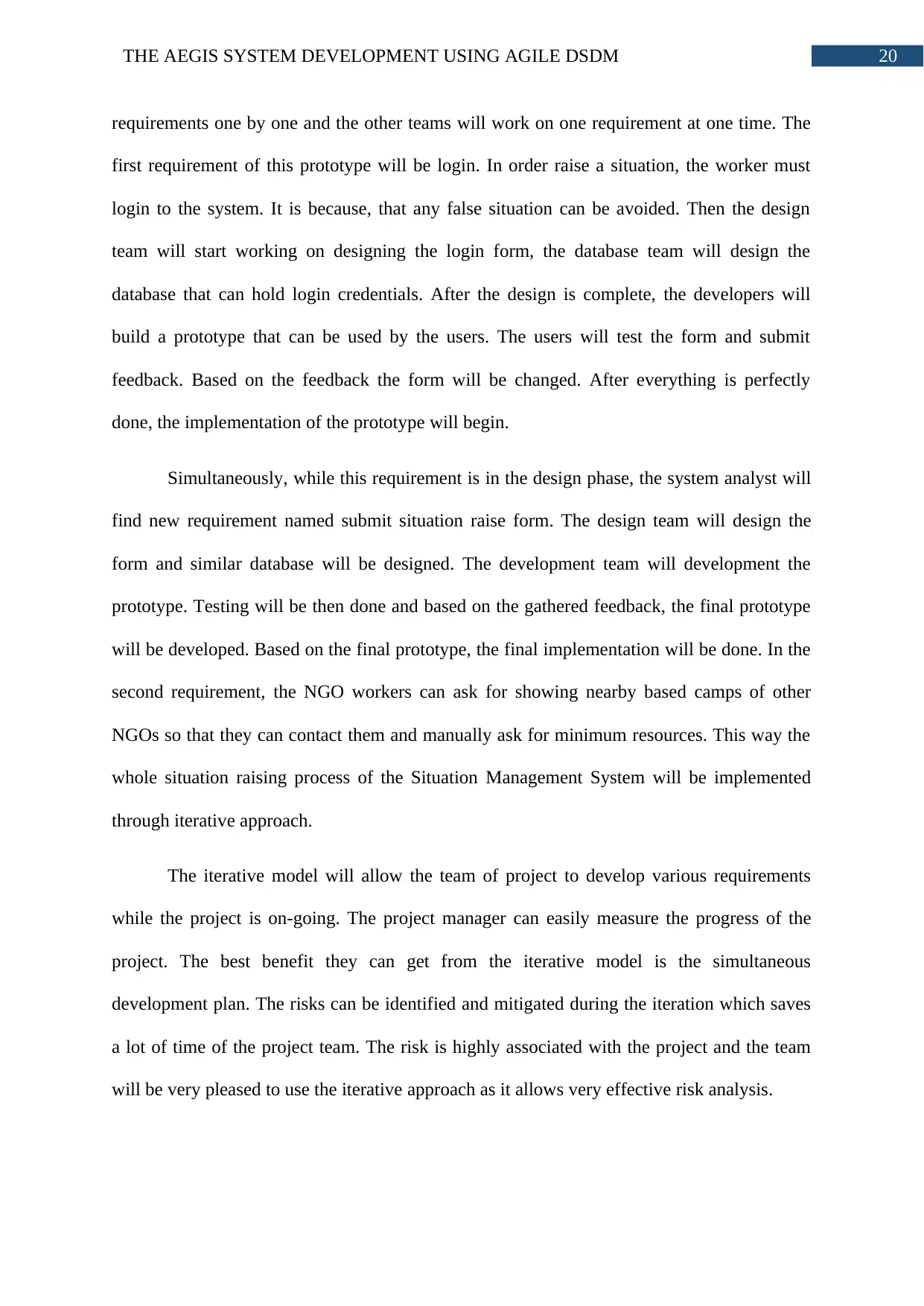
20THE AEGIS SYSTEM DEVELOPMENT USING AGILE DSDM
requirements one by one and the other teams will work on one requirement at one time. The
first requirement of this prototype will be login. In order raise a situation, the worker must
login to the system. It is because, that any false situation can be avoided. Then the design
team will start working on designing the login form, the database team will design the
database that can hold login credentials. After the design is complete, the developers will
build a prototype that can be used by the users. The users will test the form and submit
feedback. Based on the feedback the form will be changed. After everything is perfectly
done, the implementation of the prototype will begin.
Simultaneously, while this requirement is in the design phase, the system analyst will
find new requirement named submit situation raise form. The design team will design the
form and similar database will be designed. The development team will development the
prototype. Testing will be then done and based on the gathered feedback, the final prototype
will be developed. Based on the final prototype, the final implementation will be done. In the
second requirement, the NGO workers can ask for showing nearby based camps of other
NGOs so that they can contact them and manually ask for minimum resources. This way the
whole situation raising process of the Situation Management System will be implemented
through iterative approach.
The iterative model will allow the team of project to develop various requirements
while the project is on-going. The project manager can easily measure the progress of the
project. The best benefit they can get from the iterative model is the simultaneous
development plan. The risks can be identified and mitigated during the iteration which saves
a lot of time of the project team. The risk is highly associated with the project and the team
will be very pleased to use the iterative approach as it allows very effective risk analysis.
requirements one by one and the other teams will work on one requirement at one time. The
first requirement of this prototype will be login. In order raise a situation, the worker must
login to the system. It is because, that any false situation can be avoided. Then the design
team will start working on designing the login form, the database team will design the
database that can hold login credentials. After the design is complete, the developers will
build a prototype that can be used by the users. The users will test the form and submit
feedback. Based on the feedback the form will be changed. After everything is perfectly
done, the implementation of the prototype will begin.
Simultaneously, while this requirement is in the design phase, the system analyst will
find new requirement named submit situation raise form. The design team will design the
form and similar database will be designed. The development team will development the
prototype. Testing will be then done and based on the gathered feedback, the final prototype
will be developed. Based on the final prototype, the final implementation will be done. In the
second requirement, the NGO workers can ask for showing nearby based camps of other
NGOs so that they can contact them and manually ask for minimum resources. This way the
whole situation raising process of the Situation Management System will be implemented
through iterative approach.
The iterative model will allow the team of project to develop various requirements
while the project is on-going. The project manager can easily measure the progress of the
project. The best benefit they can get from the iterative model is the simultaneous
development plan. The risks can be identified and mitigated during the iteration which saves
a lot of time of the project team. The risk is highly associated with the project and the team
will be very pleased to use the iterative approach as it allows very effective risk analysis.
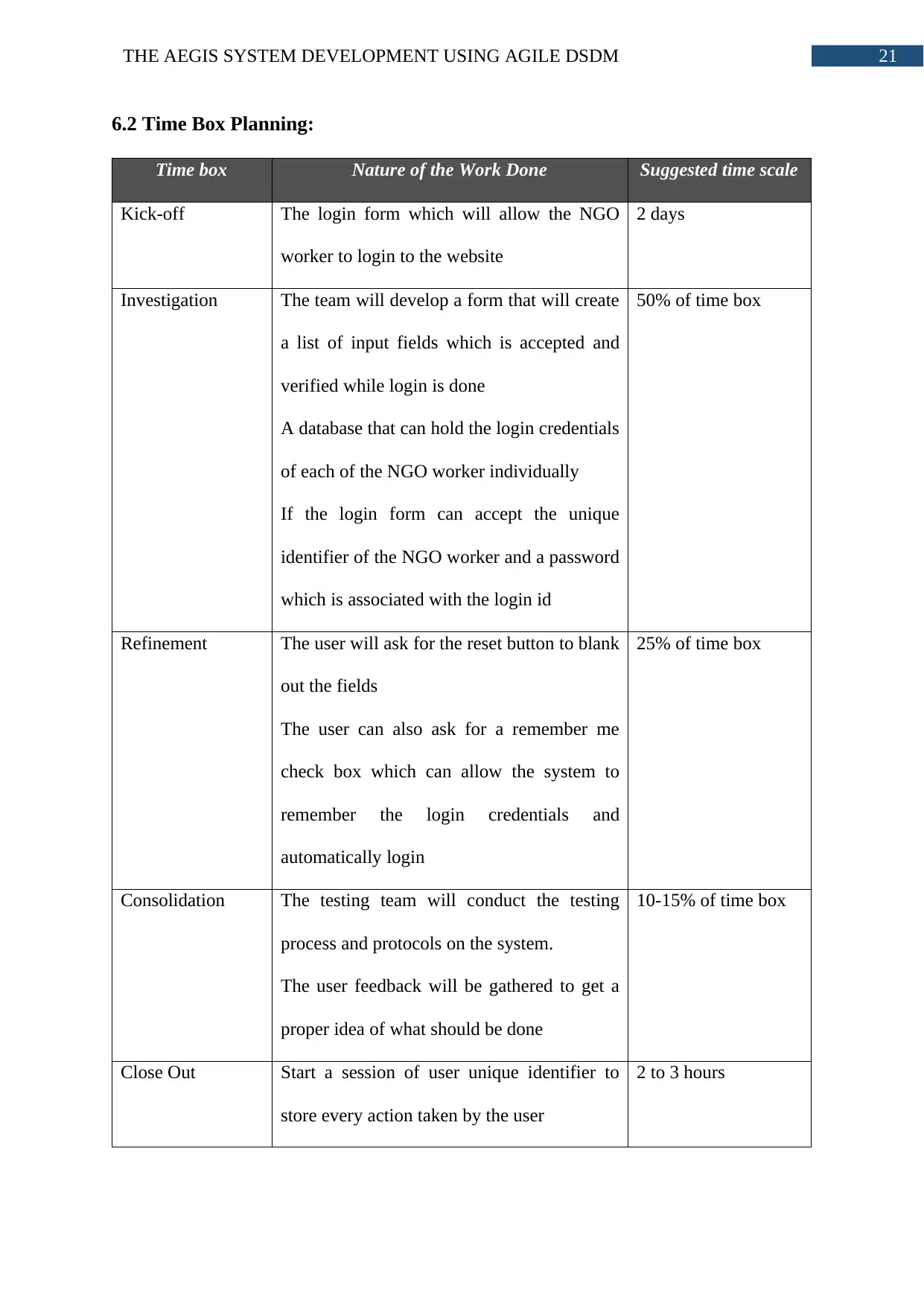
21THE AEGIS SYSTEM DEVELOPMENT USING AGILE DSDM
6.2 Time Box Planning:
Time box Nature of the Work Done Suggested time scale
Kick-off The login form which will allow the NGO
worker to login to the website
2 days
Investigation The team will develop a form that will create
a list of input fields which is accepted and
verified while login is done
A database that can hold the login credentials
of each of the NGO worker individually
If the login form can accept the unique
identifier of the NGO worker and a password
which is associated with the login id
50% of time box
Refinement The user will ask for the reset button to blank
out the fields
The user can also ask for a remember me
check box which can allow the system to
remember the login credentials and
automatically login
25% of time box
Consolidation The testing team will conduct the testing
process and protocols on the system.
The user feedback will be gathered to get a
proper idea of what should be done
10-15% of time box
Close Out Start a session of user unique identifier to
store every action taken by the user
2 to 3 hours
6.2 Time Box Planning:
Time box Nature of the Work Done Suggested time scale
Kick-off The login form which will allow the NGO
worker to login to the website
2 days
Investigation The team will develop a form that will create
a list of input fields which is accepted and
verified while login is done
A database that can hold the login credentials
of each of the NGO worker individually
If the login form can accept the unique
identifier of the NGO worker and a password
which is associated with the login id
50% of time box
Refinement The user will ask for the reset button to blank
out the fields
The user can also ask for a remember me
check box which can allow the system to
remember the login credentials and
automatically login
25% of time box
Consolidation The testing team will conduct the testing
process and protocols on the system.
The user feedback will be gathered to get a
proper idea of what should be done
10-15% of time box
Close Out Start a session of user unique identifier to
store every action taken by the user
2 to 3 hours
Paraphrase This Document
Need a fresh take? Get an instant paraphrase of this document with our AI Paraphraser
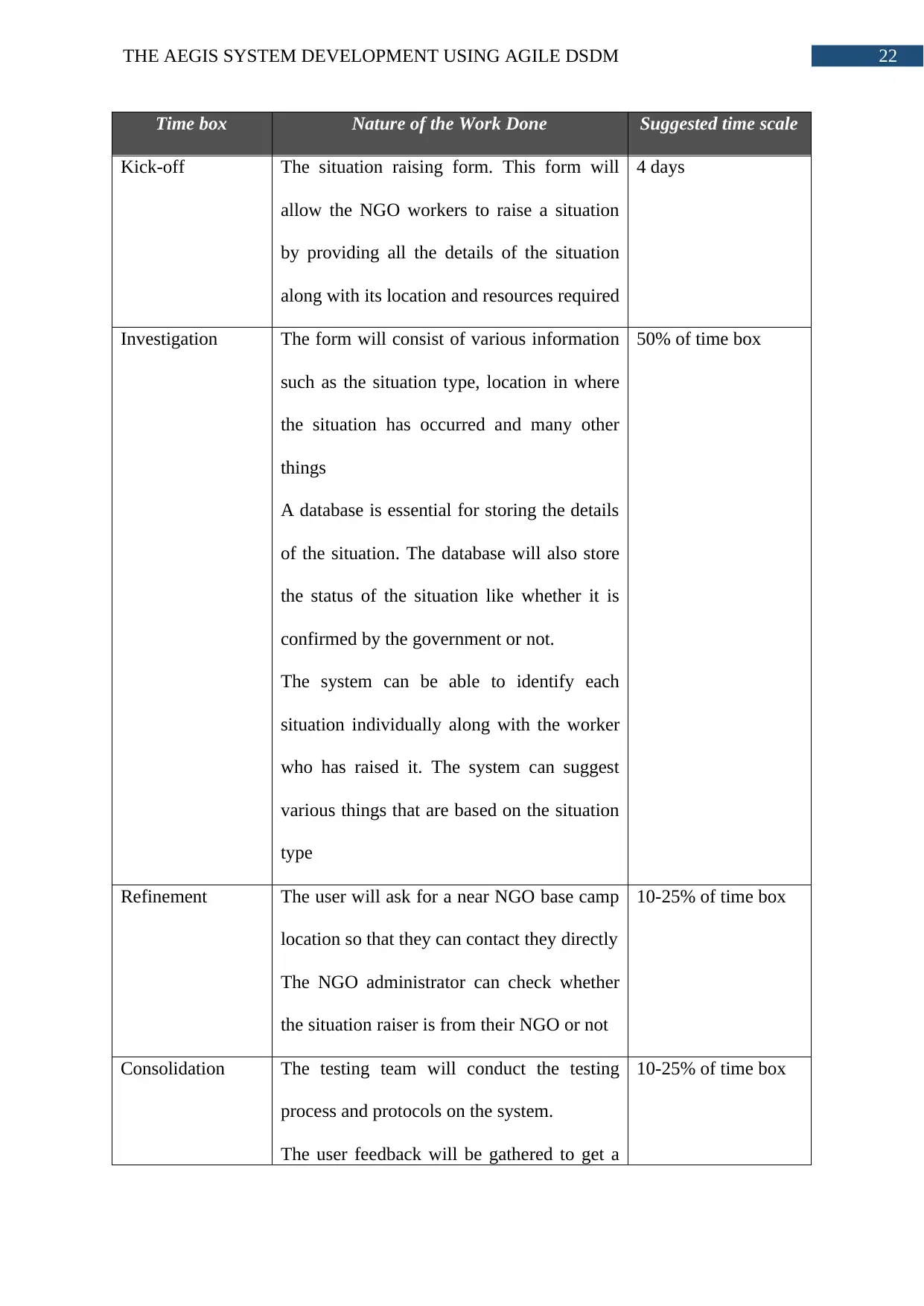
22THE AEGIS SYSTEM DEVELOPMENT USING AGILE DSDM
Time box Nature of the Work Done Suggested time scale
Kick-off The situation raising form. This form will
allow the NGO workers to raise a situation
by providing all the details of the situation
along with its location and resources required
4 days
Investigation The form will consist of various information
such as the situation type, location in where
the situation has occurred and many other
things
A database is essential for storing the details
of the situation. The database will also store
the status of the situation like whether it is
confirmed by the government or not.
The system can be able to identify each
situation individually along with the worker
who has raised it. The system can suggest
various things that are based on the situation
type
50% of time box
Refinement The user will ask for a near NGO base camp
location so that they can contact they directly
The NGO administrator can check whether
the situation raiser is from their NGO or not
10-25% of time box
Consolidation The testing team will conduct the testing
process and protocols on the system.
The user feedback will be gathered to get a
10-25% of time box
Time box Nature of the Work Done Suggested time scale
Kick-off The situation raising form. This form will
allow the NGO workers to raise a situation
by providing all the details of the situation
along with its location and resources required
4 days
Investigation The form will consist of various information
such as the situation type, location in where
the situation has occurred and many other
things
A database is essential for storing the details
of the situation. The database will also store
the status of the situation like whether it is
confirmed by the government or not.
The system can be able to identify each
situation individually along with the worker
who has raised it. The system can suggest
various things that are based on the situation
type
50% of time box
Refinement The user will ask for a near NGO base camp
location so that they can contact they directly
The NGO administrator can check whether
the situation raiser is from their NGO or not
10-25% of time box
Consolidation The testing team will conduct the testing
process and protocols on the system.
The user feedback will be gathered to get a
10-25% of time box

23THE AEGIS SYSTEM DEVELOPMENT USING AGILE DSDM
proper idea of what should be done
Close Out Start the situation alert so that government
administrator can see the situation raise as
soon as it is submitted to the system
2 to 3 hours
6.3 Changes Asked by the User:
Users Change request Status
NGO Worker Adding a reset button so that they can
reset the entered data and correctly
put the data again
Done
NGO Worker Adding a ‘remember me’ check box
so that they do not have to login to
the website. This button only works
when it is clicked
Done
NGO Worker Nearby NGO base camp location. So
that they can manually reach there
and collect emergency resources
Done
proper idea of what should be done
Close Out Start the situation alert so that government
administrator can see the situation raise as
soon as it is submitted to the system
2 to 3 hours
6.3 Changes Asked by the User:
Users Change request Status
NGO Worker Adding a reset button so that they can
reset the entered data and correctly
put the data again
Done
NGO Worker Adding a ‘remember me’ check box
so that they do not have to login to
the website. This button only works
when it is clicked
Done
NGO Worker Nearby NGO base camp location. So
that they can manually reach there
and collect emergency resources
Done

24THE AEGIS SYSTEM DEVELOPMENT USING AGILE DSDM
Figure 6: Changed Situation Raise Prototype
(Source: Created by Author)
Figure 6: Changed Situation Raise Prototype
(Source: Created by Author)
Secure Best Marks with AI Grader
Need help grading? Try our AI Grader for instant feedback on your assignments.
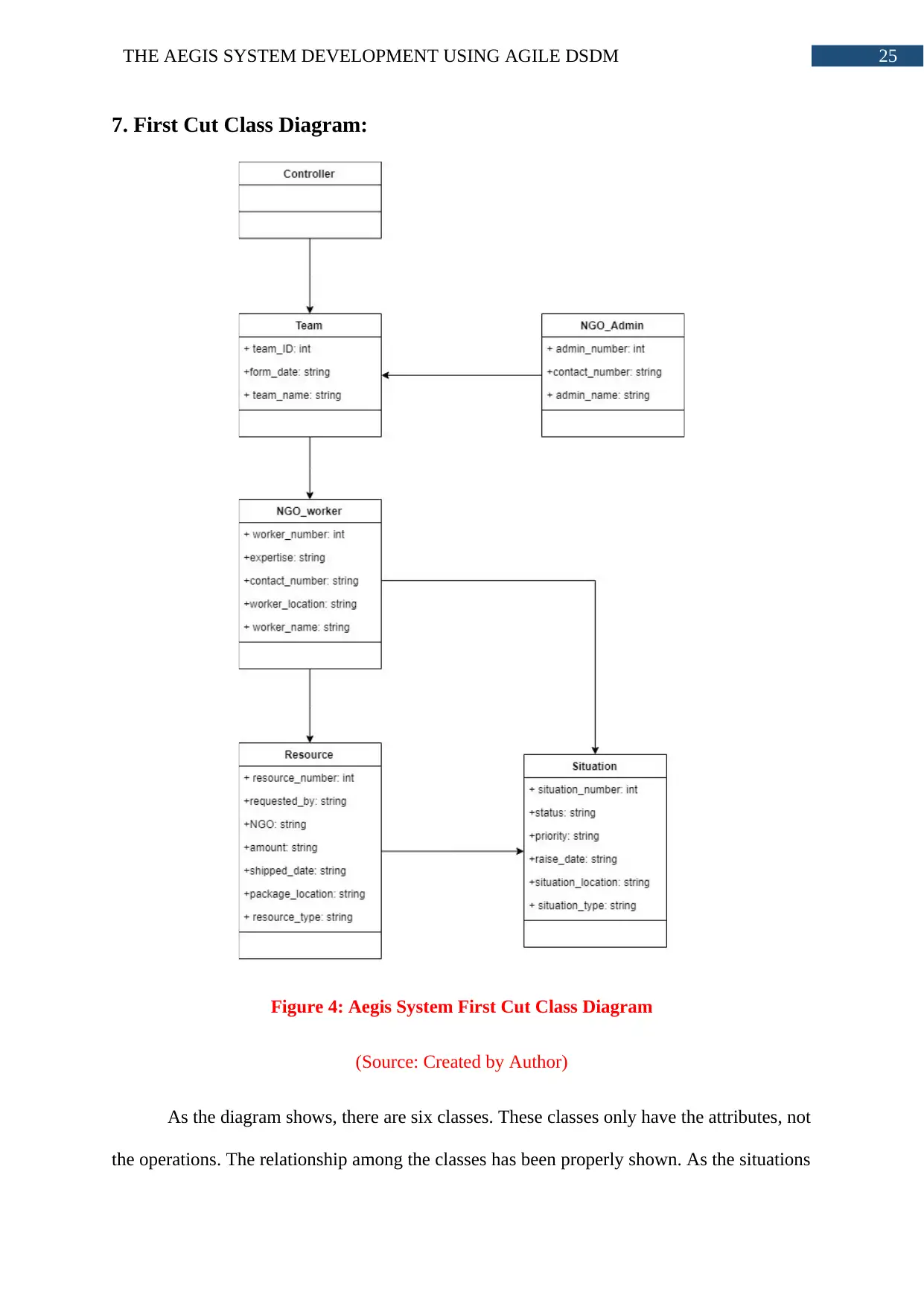
25THE AEGIS SYSTEM DEVELOPMENT USING AGILE DSDM
7. First Cut Class Diagram:
Figure 4: Aegis System First Cut Class Diagram
(Source: Created by Author)
As the diagram shows, there are six classes. These classes only have the attributes, not
the operations. The relationship among the classes has been properly shown. As the situations
7. First Cut Class Diagram:
Figure 4: Aegis System First Cut Class Diagram
(Source: Created by Author)
As the diagram shows, there are six classes. These classes only have the attributes, not
the operations. The relationship among the classes has been properly shown. As the situations
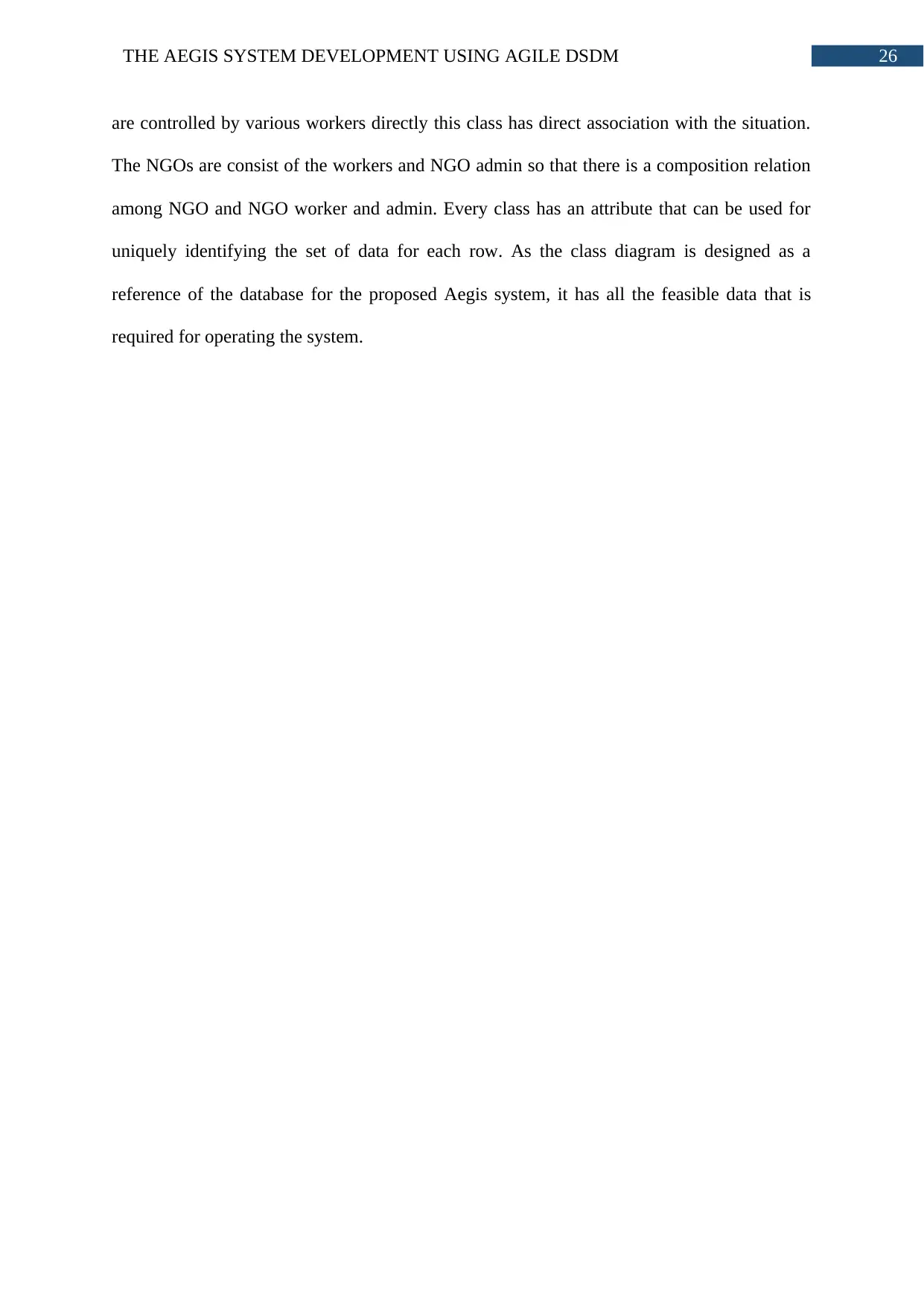
26THE AEGIS SYSTEM DEVELOPMENT USING AGILE DSDM
are controlled by various workers directly this class has direct association with the situation.
The NGOs are consist of the workers and NGO admin so that there is a composition relation
among NGO and NGO worker and admin. Every class has an attribute that can be used for
uniquely identifying the set of data for each row. As the class diagram is designed as a
reference of the database for the proposed Aegis system, it has all the feasible data that is
required for operating the system.
are controlled by various workers directly this class has direct association with the situation.
The NGOs are consist of the workers and NGO admin so that there is a composition relation
among NGO and NGO worker and admin. Every class has an attribute that can be used for
uniquely identifying the set of data for each row. As the class diagram is designed as a
reference of the database for the proposed Aegis system, it has all the feasible data that is
required for operating the system.
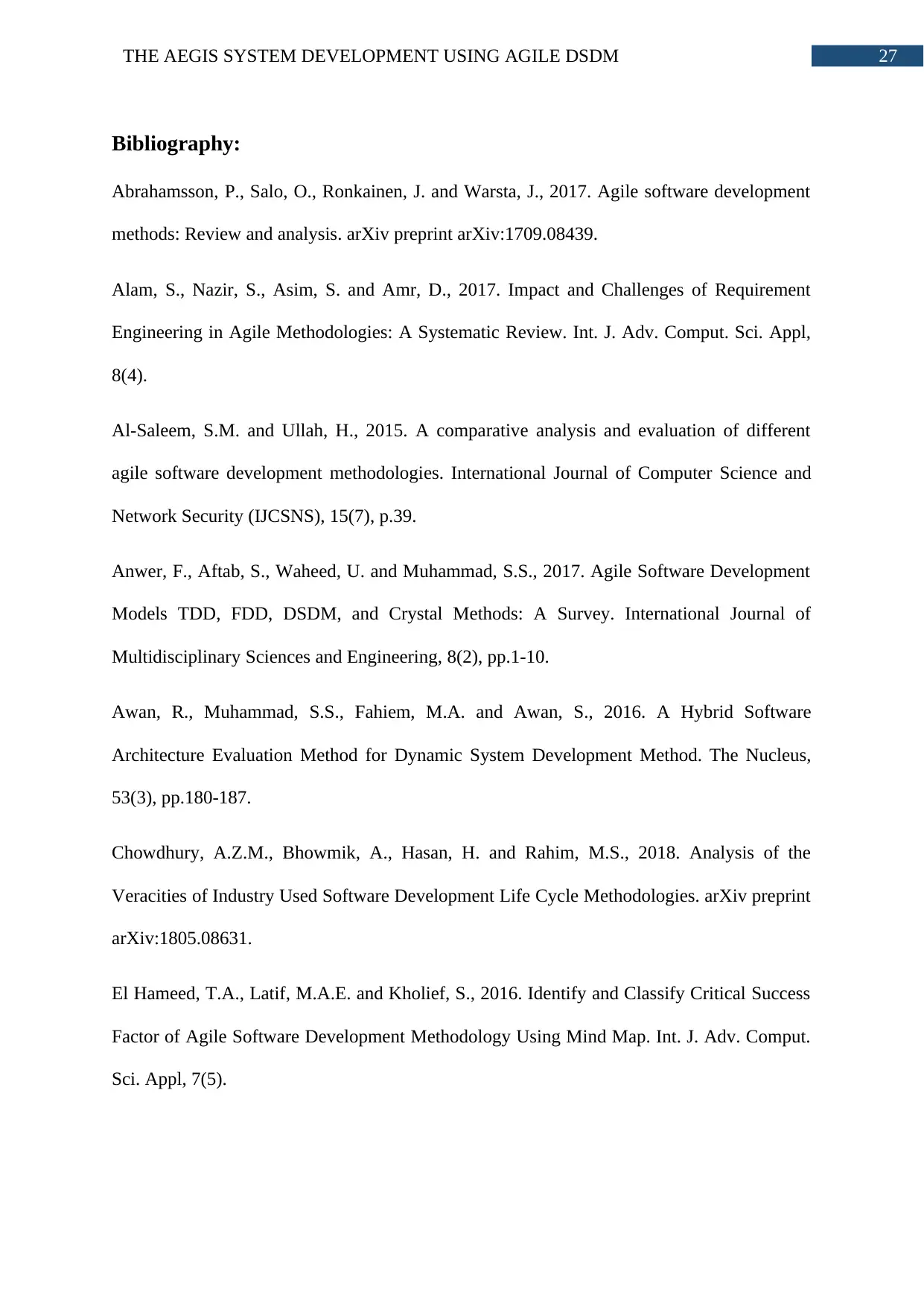
27THE AEGIS SYSTEM DEVELOPMENT USING AGILE DSDM
Bibliography:
Abrahamsson, P., Salo, O., Ronkainen, J. and Warsta, J., 2017. Agile software development
methods: Review and analysis. arXiv preprint arXiv:1709.08439.
Alam, S., Nazir, S., Asim, S. and Amr, D., 2017. Impact and Challenges of Requirement
Engineering in Agile Methodologies: A Systematic Review. Int. J. Adv. Comput. Sci. Appl,
8(4).
Al-Saleem, S.M. and Ullah, H., 2015. A comparative analysis and evaluation of different
agile software development methodologies. International Journal of Computer Science and
Network Security (IJCSNS), 15(7), p.39.
Anwer, F., Aftab, S., Waheed, U. and Muhammad, S.S., 2017. Agile Software Development
Models TDD, FDD, DSDM, and Crystal Methods: A Survey. International Journal of
Multidisciplinary Sciences and Engineering, 8(2), pp.1-10.
Awan, R., Muhammad, S.S., Fahiem, M.A. and Awan, S., 2016. A Hybrid Software
Architecture Evaluation Method for Dynamic System Development Method. The Nucleus,
53(3), pp.180-187.
Chowdhury, A.Z.M., Bhowmik, A., Hasan, H. and Rahim, M.S., 2018. Analysis of the
Veracities of Industry Used Software Development Life Cycle Methodologies. arXiv preprint
arXiv:1805.08631.
El Hameed, T.A., Latif, M.A.E. and Kholief, S., 2016. Identify and Classify Critical Success
Factor of Agile Software Development Methodology Using Mind Map. Int. J. Adv. Comput.
Sci. Appl, 7(5).
Bibliography:
Abrahamsson, P., Salo, O., Ronkainen, J. and Warsta, J., 2017. Agile software development
methods: Review and analysis. arXiv preprint arXiv:1709.08439.
Alam, S., Nazir, S., Asim, S. and Amr, D., 2017. Impact and Challenges of Requirement
Engineering in Agile Methodologies: A Systematic Review. Int. J. Adv. Comput. Sci. Appl,
8(4).
Al-Saleem, S.M. and Ullah, H., 2015. A comparative analysis and evaluation of different
agile software development methodologies. International Journal of Computer Science and
Network Security (IJCSNS), 15(7), p.39.
Anwer, F., Aftab, S., Waheed, U. and Muhammad, S.S., 2017. Agile Software Development
Models TDD, FDD, DSDM, and Crystal Methods: A Survey. International Journal of
Multidisciplinary Sciences and Engineering, 8(2), pp.1-10.
Awan, R., Muhammad, S.S., Fahiem, M.A. and Awan, S., 2016. A Hybrid Software
Architecture Evaluation Method for Dynamic System Development Method. The Nucleus,
53(3), pp.180-187.
Chowdhury, A.Z.M., Bhowmik, A., Hasan, H. and Rahim, M.S., 2018. Analysis of the
Veracities of Industry Used Software Development Life Cycle Methodologies. arXiv preprint
arXiv:1805.08631.
El Hameed, T.A., Latif, M.A.E. and Kholief, S., 2016. Identify and Classify Critical Success
Factor of Agile Software Development Methodology Using Mind Map. Int. J. Adv. Comput.
Sci. Appl, 7(5).
Paraphrase This Document
Need a fresh take? Get an instant paraphrase of this document with our AI Paraphraser

28THE AEGIS SYSTEM DEVELOPMENT USING AGILE DSDM
Fahad, M., Qadri, S., Ullah, S., Husnain, M., Qaiser, R., Ahmed, S., Qureshi, W.A. and
Muhammad, S.S., 2017. A Comparative Analysis of DXPRUM and DSDM. IJCSNS, 17(5),
p.259.
Faitelson, D. and Tyszberowicz, S., 2017, May. UML Diagram Refinement (focusing on
class-and use case diagrams). In Proceedings of the 39th International Conference on
Software Engineering (pp. 735-745). IEEE Press.
Margini, A., Cutrona, G. and Fantuzzi, C., 2017. COMPARISON OF DIFFERENT AGILE
METHODOLOGIES AND FIT ASSESSMENT IN AN INDUSTRIAL CONTEXT.
INTERNATIONAL JOURNAL OF ADVANCED RESEARCH, 5(7), pp.673-690.
Matharu, G.S., Mishra, A., Singh, H. and Upadhyay, P., 2015. Empirical study of agile
software development methodologies: A comparative analysis. ACM SIGSOFT Software
Engineering Notes, 40(1), pp.1-6.
Rasnacis, A. and Berzisa, S., 2017. Method for adaptation and implementation of Agile
project management methodology. Procedia Computer Science, 104, pp.43-50.
Rhazali, Y., Hadi, Y. and Mouloudi, A., 2014. Transformation method CIM to PIM: from
business processes models defined in BPMN to use case and class models defined in UML.
International Journal of Computer, Electrical, Automation, Control and Information
Engineering, 8(8), pp.1453-1457.
Rojas, L.A. and Macías, J.A., 2015, September. An Agile Information-Architecture-Driven
Approach for the Development of User-Centered Interactive Software. In Proceedings of the
XVI International Conference on Human Computer Interaction (p. 50). ACM.
Rumbaugh, J., Booch, G. and Jacobson, I., 2017. The unified modeling language reference
manual. Addison Wesley.
Fahad, M., Qadri, S., Ullah, S., Husnain, M., Qaiser, R., Ahmed, S., Qureshi, W.A. and
Muhammad, S.S., 2017. A Comparative Analysis of DXPRUM and DSDM. IJCSNS, 17(5),
p.259.
Faitelson, D. and Tyszberowicz, S., 2017, May. UML Diagram Refinement (focusing on
class-and use case diagrams). In Proceedings of the 39th International Conference on
Software Engineering (pp. 735-745). IEEE Press.
Margini, A., Cutrona, G. and Fantuzzi, C., 2017. COMPARISON OF DIFFERENT AGILE
METHODOLOGIES AND FIT ASSESSMENT IN AN INDUSTRIAL CONTEXT.
INTERNATIONAL JOURNAL OF ADVANCED RESEARCH, 5(7), pp.673-690.
Matharu, G.S., Mishra, A., Singh, H. and Upadhyay, P., 2015. Empirical study of agile
software development methodologies: A comparative analysis. ACM SIGSOFT Software
Engineering Notes, 40(1), pp.1-6.
Rasnacis, A. and Berzisa, S., 2017. Method for adaptation and implementation of Agile
project management methodology. Procedia Computer Science, 104, pp.43-50.
Rhazali, Y., Hadi, Y. and Mouloudi, A., 2014. Transformation method CIM to PIM: from
business processes models defined in BPMN to use case and class models defined in UML.
International Journal of Computer, Electrical, Automation, Control and Information
Engineering, 8(8), pp.1453-1457.
Rojas, L.A. and Macías, J.A., 2015, September. An Agile Information-Architecture-Driven
Approach for the Development of User-Centered Interactive Software. In Proceedings of the
XVI International Conference on Human Computer Interaction (p. 50). ACM.
Rumbaugh, J., Booch, G. and Jacobson, I., 2017. The unified modeling language reference
manual. Addison Wesley.
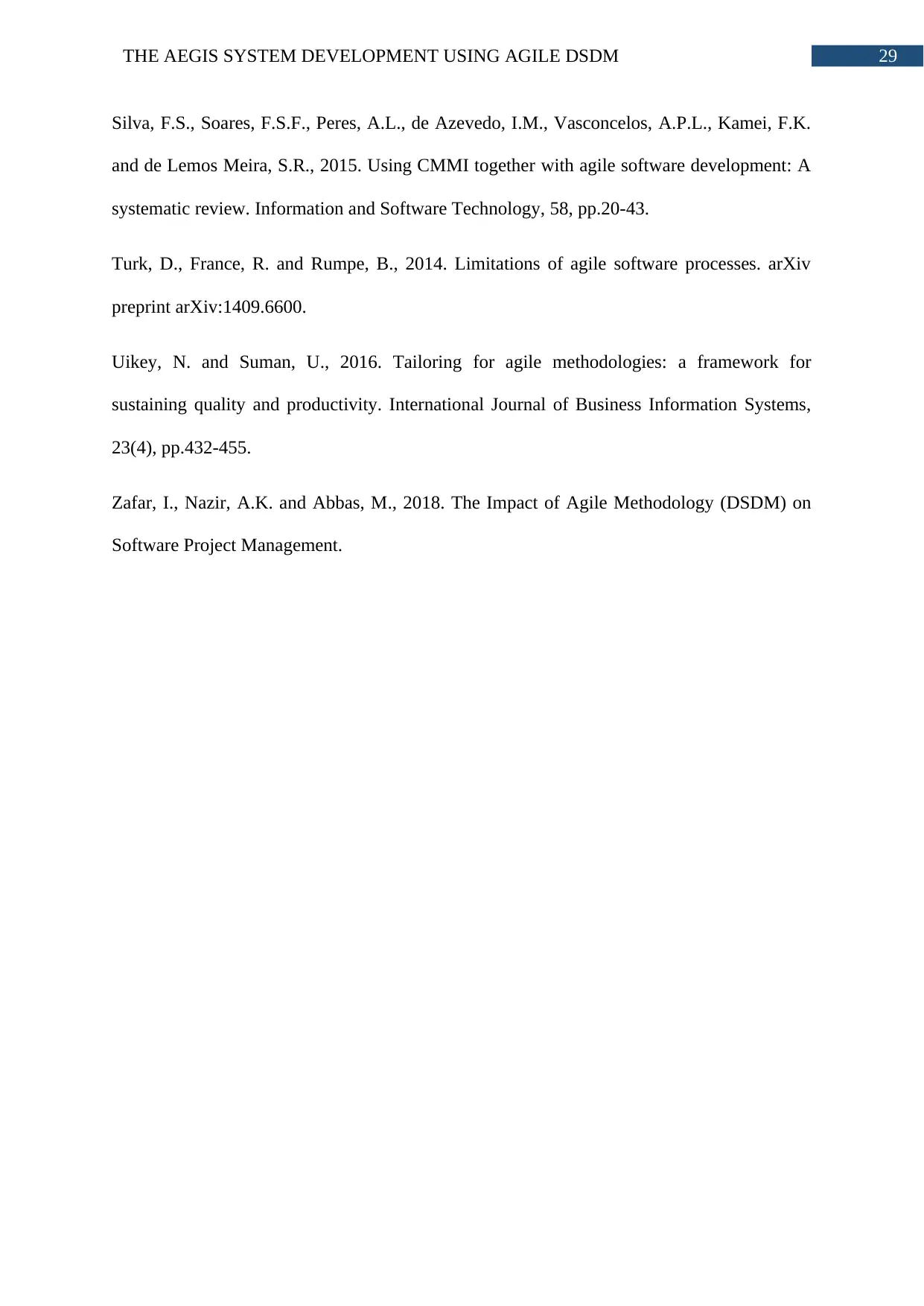
29THE AEGIS SYSTEM DEVELOPMENT USING AGILE DSDM
Silva, F.S., Soares, F.S.F., Peres, A.L., de Azevedo, I.M., Vasconcelos, A.P.L., Kamei, F.K.
and de Lemos Meira, S.R., 2015. Using CMMI together with agile software development: A
systematic review. Information and Software Technology, 58, pp.20-43.
Turk, D., France, R. and Rumpe, B., 2014. Limitations of agile software processes. arXiv
preprint arXiv:1409.6600.
Uikey, N. and Suman, U., 2016. Tailoring for agile methodologies: a framework for
sustaining quality and productivity. International Journal of Business Information Systems,
23(4), pp.432-455.
Zafar, I., Nazir, A.K. and Abbas, M., 2018. The Impact of Agile Methodology (DSDM) on
Software Project Management.
Silva, F.S., Soares, F.S.F., Peres, A.L., de Azevedo, I.M., Vasconcelos, A.P.L., Kamei, F.K.
and de Lemos Meira, S.R., 2015. Using CMMI together with agile software development: A
systematic review. Information and Software Technology, 58, pp.20-43.
Turk, D., France, R. and Rumpe, B., 2014. Limitations of agile software processes. arXiv
preprint arXiv:1409.6600.
Uikey, N. and Suman, U., 2016. Tailoring for agile methodologies: a framework for
sustaining quality and productivity. International Journal of Business Information Systems,
23(4), pp.432-455.
Zafar, I., Nazir, A.K. and Abbas, M., 2018. The Impact of Agile Methodology (DSDM) on
Software Project Management.
1 out of 30
![[object Object]](/_next/static/media/star-bottom.7253800d.svg)





